Home Blog Presentation Ideas About Me Slides: How to Introduce Yourself in a Presentation

About Me Slides: How to Introduce Yourself in a Presentation

From conference talks to client demos, it’s always essential to include an About Me slide in any presentation you are giving. Introducing yourself early into the presentation helps build a better rapport with the audience.
You can start with several fun facts about me slide to break the ice or go for a more formal professional bio to explain your background and what makes you qualified to talk about the topic at hand. At any rate, your goal is to get the audience on your side by revealing some of your personality.
How to Introduce Yourself in a Presentation: 4 Approaches
It’s a good practice to include self-introduction slides at the beginning of your presentation. If you are looking to answer how to introduce yourself professionally, typically somewhere after the title, opening slide , and the main agenda. However, the presentation structure will be somewhat different depending on whether you are presenting to a new audience or a group of people familiar with (e.g., your team, clients, or business partners).
Here are four about me slide ideas you can try out, plus an About me template you can use to present yourself in a presentation.

1. Mention Your Name and Affiliations
Start with the introduction basics. State your name, company, title/position, and several quick facts about who you are and what you do. Even if you present to a familiar audience, a brief recap is always welcome.
To keep things a bit more engaging, consider adding some lesser-known facts about yourself. For example:
- Your interests
- Recent accomplishments
- Testimonial/quote from a team member
- Fun nicknames you got
The above can be nice ice breakers for less formal team presentations, project updates, or catch-ups with clients.
Here are several unique About Me examples you can try out:
For a client case study presentation :
“Hi, I’m Lynda, Chief Customer Success Specialist with Acme Corp. (Also, someone you thought was a chatbot for the first few encounters)
47 NPS | 15% Churn Rate | 40% repeat purchase rate”
For a team after-action review presentation :
Mike, Project Manager at Cool Project
(aka Maximizer)
Personal Project stats:
387 Slack messages answered
56 cups of coffee consumed
Project profit gross margin: $1.2 million
2. Work On Your Elevator Pitch
One of the best ways to introduce yourself in a presentation is to share a punchy elevator pitch. This works extra well if you are presenting to a new audience.
An elevator pitch is a concise statement (1-2 sentences) that summarizes your unique strengths, skills, and abilities and explains how these can benefit your listener.
It’s nice to have one ready for your presentations and networking in general since it helps you immediately connect with new people and communicate your value.
Writing a solid elevator pitch may require several attempts and iterations. But the sooner you start — the faster you’ll arrive at the best formula!
To get your creative juices flowing, here are several elevator pitch ideas you can incorporate in an introduction slide about yourself.
For professionals:
“Certified Salesforce Administrator, data visualization specialist, and analytics for top SaaS brands. I help businesses make more sense of their data to drive better outcomes”.
For a mentor :
“Adjunct professor of creative writing at Columbia University, published author, former lifestyle editor at Esquire, the New York Times. I can teach you how to find, shape, pitch, and publish stories for web & print.”
For a student:
“Third-year Marine Biology student at Denver State Uni. Volunteer at Lake Life Protection NGO, climate change activist, looking to expand my research about water conservation”.
3. Answer Popular Questions or Assumptions
If you are a frequent presenter , chances are you get asked a lot of the same “About Me questions” after your speeches and during the networking bits. So why not address a roaster of these in your About Me slide? Select 4-5 most common questions and list them as quick FAQs on your slide deck.
4. Focus on Telling a Story
Strong introductions are personable. They are meant to offer a sneak-peak into your personality and the passion behind your work. That’s why for less formal presentations, you can (and should!) start with a short personal story.
Remember: reliability is important to “click” with your audience.
For instance, neuroscience research of political ads recently found that ads featuring real people performed better than those with genetic stock footage. Among viewers, emotional engagement and memory encoding (recall) increased dramatically when political ads showed relatable people.
The same holds true for commerce. In 2015, GE launched a viral “What’s the Matter With Owen?” video ad series to attract more young talent to the company. The clips featured a relatable protagonist, struggling to explain what his work at GE entails e.g. that the company isn’t building railroads, but actually does some very innovative pilots. Many engineers related to the promo and work applications to GE shoot up by 800% !
As the above examples show, a good relatable story can go a long way. So think about how you can make a PowerPoint presentation about yourself more representative of who you really are as a person.
How to Give a Presentation About Yourself: 4 Fool-Proof Tips
On other occasions, you may be asked to give a full-length “about me” presentation. Typically, this is the case during a second interview, onboarding , or if you are in attending a training program or workshop where everyone needs to present themselves and their work.
Obviously, you’ll need more than one good about me slide in this case. So here’s how to prepare a superb presentation about me.
What to Put in a Presentation About Yourself?
The audience will expect to learn a mix of personal and professional facts about you. Thus, it’s a good idea to include the following information:
- Your name, contact info, website , social media handles, digital portfolio .
- Short bio or some interesting snippets.
- Career timeline (if applicable).
- Main achievements (preferably quantifiable).
- Education, special training.
- Digital badging awards , accolades, and other types of recognition.
- Something more personal — an interest, hobby, aspiration.
The above mix of items will change a bit, depending on whether you are giving an interview presentation about yourself or introduce yourself post-hiring. For example, in some cases a dedicated bio slide may be useful, but other times focusing on main achievements and goals can be better.
That being said, let’s take a closer look at how to organize the above information in a memorable presentation.
P.S. Grab an about me slide template to make the design process easier!

1. Create a List of “Facts About Me”
The easiest way to answer the “tell me about yourself” question is by having an array of facts you can easily fetch from your brain.
When it comes to a full-length about me presentation , it’s best to have a longer list ready. To keep your brainstorming process productive, organize all your ideas in the following buckets:
- Key skills (soft and hard)
- Educational accolades, training
- Accomplishments and other “bragging rights”
- Personal tidbits (a.k.a. fun facts )
Once you have a list, it gets easier to build a series of slides around it.
2. Think Like Your Audience
Most likely you’d be asked to make a presentation about yourself by a recruiter. There’s a good reason why many ask this — they want to determine if you are a good “cultural fit” for their organization.
After all, 33% of people quit within the first 3 months of accepting a new job. Among these:
- 43% of employees quit because their day-to-day role was different than what they were told it would be during the hiring process.
- 32% cite company culture as a factor for leaving within the first three months.
About me presentations often serve as an extra “filter” helping both parties ensure that they are on the same page expectations- and work style-wise. Thus, when you prepare your slide deck, do some background company research. Then try to align the presentation with it by matching the company tone, communication style, and cultural values.
3. Include Testimonials and Recommendations
Use the voice of others to back up the claims you are making in your presentation. After all, trumping your own horn is what you are expected to do in such a presentation. But the voices of others can strengthen the claims you are personally making.
Depending on your role and industry, try to sprinkle some of the following testimonials:
- LinkedIn recommendations
- Quotes from personal or professional references
- Social media comments
- Data metrics of your performance
- Funny assessments from your colleagues/friends
The above not just strengthen your narrative, but also help the audience learn some extras about you and your background. Testimonial slides can be of help for this purpose.
4. Include a Case Study
One of the best ways to illustrate who you are is to show what you are best in. Remember, an about me presentation often needs to “soft sell” your qualifications, experience, and personality.
One of the best ways to do that is to showcase how you can feel in a specific need and solve issues the business is facing.
So if you have the timeframe, use some of the ending slides to deliver a quick case study. You can present:
- Short retrospective of a past successful project
- Before-after transformations you’ve achieved
- Spotlight of the main accomplishments within the previous role
- Main customer results obtained
- Specific solution delivered by you (or the team you’ve worked with)
Ending your presentation on such a high note will leave the audience positively impressed and wondering what results you could achieve for them.
To Conclude
It’s easy to feel stumped when you are asked to talk about yourself. Because there are so many things you could mention (but not necessarily should). At the same time, you don’t want to make your introduction sound like a bragging context. So always think from the position of your audience. Do the facts you choose to share benefit them in any way? If yes, place them confidently on your About Me slides!
1. Personal Self Introduction PowerPoint Template

Use This Template
2. Self Introduction PowerPoint Template

3. Meet the Team PowerPoint Template Slides

4. Introduce Company Profile PowerPoint Template

5. Modern 1-Page Resume Template for PowerPoint

6. Modern Resume Presentation Template

Like this article? Please share
Introduce Yourself, Introduction, Presentation Ideas Filed under Presentation Ideas
Related Articles

Filed under Design • July 3rd, 2024
ChatGPT Prompts for Presentations
Make ChatGPT your best ally for presentation design. Learn how to create effective ChatGPT prompts for presentations here.

Filed under Design • July 1st, 2024
Calculating the Slide Count: How Many Slides Do I Need for a Presentation?
There’s no magical formula for estimating presentation slides, but this guide can help us approximate the number of slides we need for a presentation.
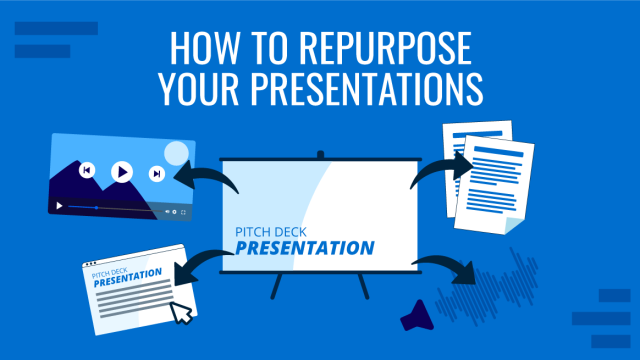
Filed under Design • June 27th, 2024
How to Repurpose Your Content on Presentations
Adapt your content from presentation slides into other mediums and viceversa by learning how to repurpose your presentations. Detailed guide here.
Leave a Reply
CHICAGO AUGUST 29-30 PUBLIC SPEAKING CLASS IS ALMOST FULL! RESERVE YOUR SPOT NOW

- Public Speaking Classes
- Corporate Presentation Training
- Online Public Speaking Course
- Northeast Region
- Midwest Region
- Southeast Region
- Central Region
- Western Region
- Presentation Skills
- 101 Public Speaking Tips
- Fear of Public Speaking
How to Introduce Yourself in a Presentation [with Examples]

In this post, we are going to cover the best way, a very simple three-step process that will help you introduce yourself in a presentation. A summary of the steps is below.
- Start with your name and company (or organization or school).
- Tell your audience what problem you can solve for them.
- Share some type of proof (social proof works best) that you can solve this problem.
I will break down each step into a simple-to-follow process. But first… a little background.
First, Identify What Your Audience Wants from Your Presentation

So, before you design your introduction, think about what your audience wants from your presentation. Why do they want to spend their valuable time listening to you? Are going to waste their time? Or, are you going to provide them with something valuable?
For instance, I have expertise in a number of different areas. I’m a public speaking coach, a keynote speaker, a best-selling author, a search engine optimization specialist, and a popular podcaster. However, if I delivered that sentence to any audience, the most likely reaction would be, “So what?” That sentence doesn’t answer any of the above questions. The statement is also really “me-focused” not “audience-focused.”
So, when I start to design my self-introduction, I want to focus just on the area of expertise related to my topic. I’m then going to answer the questions above about that particular topic. Once you have these answers, set them aside for a second. They will be important later.
How to Introduce Yourself in a Presentation in Class.

Instead, you probably want to add in a fun way to start a speech . For example, instead of introducing yourself in your class speech and starting in an awkward way, start with a startling statistic. Or start with a summary of your conclusion. Or, you could start the presentation with an inspirational quote.
Each of these presentation starters will help you lower your nervousness and decrease your awkwardness.
If you are delivering a speech in a speech competition or to an audience who doesn’t know you try this technique. Just introduce yourself by saying your name , the school you represent , and your topic . Make it easy. This way you get to your content more quickly and lower your nervousness.
Typically, after you get the first few sentences out of the way, your nervousness will drop dramatically. Since your name, school, and topic should be very easy to remember, this takes the pressure off you during the most nervous moments.
Obviously, follow the guidelines that your teacher or coach gives you. (The competition may have specific ways they want you to introduce yourself.)
How to Introduce Yourself in a Business Presentation — A Step-by-Step Guide.

In a professional setting, when new people walk into a meeting and don’t know what to expect, they will feel uncomfortable. The easiest way to ease some of that tension is to chat with your audience as they come into the room.
By the way, if you are looking for a template for an Elevator Speech , make sure to click this link.
Step #1: Start with your name and company name (or organization).
This one is easy. Just tell your audience your name and the organization that you are representing. If your organization is not a well-known brand name, you might add a short clarifying description. For instance, most people outside of the training industry have never heard of The Leader’s Institute ®. So, my step #1 might sound something like…
Hi, I’m Doug Staneart with The Leader’s Institute ®, an international leadership development company…
Still short and sweet, but a little more clear to someone who has never heard of my company.
Should you give your job title? Well… Maybe and sometimes. Add your title into the introduction only if your title adds to your credibility.
For example, if you are delivering a financial presentation and you are the Chief Financial Officer (CFO) of your company, you might mention that. Your title adds to your credibility. However, if the CFO is delivering a presentation about the value of joining a trade association, the CFO title adds little credibility. So, there is very little value in adding the title.
Step #2: Tell your audience what problem you can solve for them.

For instance, if my topic is how to deliver presentations, I have to determine why the audience would care. What problem will they have that I can help them with? For my audiences, the problem that I most often help people with is how to eliminate public speaking fear. Once I have the problem, I add that to my introduction by using the words, “I help people…”
Hi, I’m Doug Staneart with The Leader’s Institute ®, an international leadership development company, and I help people eliminate public speaking fear.
However, if my topic is How to Close a Higher Percentage of Sales Presentations , I’d likely want to alter my introduction a little. I might say something like…
Hi, I’m Doug Staneart with The Leader’s Institute ®, an international leadership development company, and I help people design more persuasive sales presentations.
I have expertise in both areas. However, I focus my introduction on just the expertise that is applicable to this audience. If I gave the first introduction to the second audience, they will likely respond by thinking, well, I don’t really get nervous speaking, so I guess I can tune out of this speech .
So, create a problem statement starting with, “I help people…” Make the statement apply to what your audience really wants.
Step #3: Share some type of proof (social proof works best) that you can solve this problem.
By the way, if you just do steps #1 and #2, your introduction will be better than most that you will hear. However, if you add Step #3, you will gain more respect (and attention) from your audience. Without adding some type of proof that you can solve this problem, you are just giving your opinion that you are an expert. However, if you can prove it, you are also proving that you are an expert.
This is the tricky part. For some reason, most people who get to this part feel like they haven’t accomplished great things, so they diminish the great accomplishments that they do have.
For instance, an easy way to offer proof is with a personal story of how you have solved that problem in the past.
A Few Examples of How to Introduce Yourself Before a Presentation.
For instance, one of my early clients was a young accountant. When I was working with him, he came up with the following introduction, “I’m Gary Gorman with Gorman and Associates CPA’s, and I help small businesses avoid IRS audits.” It was a great, audience-focused attention-getter. (No one wants to get audited.) However, as an accountant, it wasn’t like his company was getting a lot of five-star reviews on Yelp! So, he was kind of struggling with his social proof. So, I asked him a series of questions.
Me, “How many clients do you have?”
Gary, “Over 300.”
Me, “How many small business tax returns have you processed?”
Gary, “Well, at least a couple hundred a year for 15 years.”
Me, “So, at least 3000?” He nodded. “How many of your 300 clients have been audited since you have been representing them?”
He looked at me and said, “Well, none.”
So, we just added that piece of proof to his talk of introduction.
I’m Gary Gorman with Gorman and Associates CPA’s, and I help small businesses avoid IRS audits. In fact, in my career, I’ve helped clients complete over 3000 tax returns, and not a single one has ever been audited.
Here Is How I Adjust My Introduction Based on What I Want the Audience to Do.
For my proof, I have a number of options. Just like Gary, I have had a lot of clients who have had great successes. In addition, I have published two best-selling books about public speaking. I also have hundreds of thousands of people who listen to my podcast each week. So, I can pick my evidence based on what I want my audience to do.
For instance, if I’m speaking at a convention, and I want the audience to come by my booth to purchase my books, my introduction might sound like this.
Hi, I’m Doug Staneart with The Leader’s Institute ®, an international leadership development company, and I help people eliminate public speaking fear. One of the things that I’m most know for is being the author of two best-selling books, Fearless Presentations and Mastering Presentations.
However, if I’m leading a webinar, I may want the audience to purchase a seat in one of my classes. In that case, my introduction might sound like this.
Hi, I’m Doug Staneart with The Leader’s Institute ®, an international leadership development company, and I help people eliminate public speaking fear. For instance, for the last 20 years, I’ve taught public speaking classes to over 20,000 people, and I haven’t had a single person fail to reduce their nervousness significantly in just two days.
If my goal is to get the audience to subscribe to my podcast, my intro might sound like…
Hi, I’m Doug Staneart with The Leader’s Institute ®, an international leadership development company, and I help people eliminate public speaking fear. One of the ways that I do this is with my weekly podcast called, Fearless Presentations, which has over one million downloads, so far.
Use the Form Below to Organize How to Introduce Yourself in a Presentation.
The point is that you want to design your introduction in a way that makes people pause and think, “Really? That sounds pretty good.” You want to avoid introductions that make your audience think, “So what?”
If you have a speech coming up and need a good introduction, complete the form below. We will send you your answers via email!
Can You Replace Your Introduction with a PowerPoint Slide?
Is it okay to make your first slide (or second slide) in your presentation slides an introduction? Sure. A good public speaker will often add an introduction slide with a biography, portrait, and maybe even contact information. I sometimes do this myself.
However, I NEVER read the slide to my audience. I often just have it showing while I deliver the short introduction using the guide above. This is a great way to share more of your work experience without sounding like you are bragging.
For tips about how many powerpoint slides to use in a presentation , click here.
Remember that There Is a Big Difference Between Your Introduction in a Presentation and Your Presentation Starter.
When you introduce yourself in a presentation, you will often just use a single sentence to tell the audience who you are. You only use this intro if the audience doesn’t know who you are. Your presentation starter, though, is quite different. Your presentation starter should be a brief introduction with relevant details about what you will cover in your presentation.
For details, see Great Ways to Start a Presentation . In that post, we show ways to get the attention of the audience. We also give examples of how to use an interesting hook, personal stories, and how to use humor to start a presentation.

Podcasts , presentation skills
View More Posts By Category: Free Public Speaking Tips | leadership tips | Online Courses | Past Fearless Presentations ® Classes | Podcasts | presentation skills | Uncategorized
- PRO Courses Guides New Tech Help Pro Expert Videos About wikiHow Pro Upgrade Sign In
- EDIT Edit this Article
- EXPLORE Tech Help Pro About Us Random Article Quizzes Request a New Article Community Dashboard This Or That Game Popular Categories Arts and Entertainment Artwork Books Movies Computers and Electronics Computers Phone Skills Technology Hacks Health Men's Health Mental Health Women's Health Relationships Dating Love Relationship Issues Hobbies and Crafts Crafts Drawing Games Education & Communication Communication Skills Personal Development Studying Personal Care and Style Fashion Hair Care Personal Hygiene Youth Personal Care School Stuff Dating All Categories Arts and Entertainment Finance and Business Home and Garden Relationship Quizzes Cars & Other Vehicles Food and Entertaining Personal Care and Style Sports and Fitness Computers and Electronics Health Pets and Animals Travel Education & Communication Hobbies and Crafts Philosophy and Religion Work World Family Life Holidays and Traditions Relationships Youth
- Browse Articles
- Learn Something New
- Quizzes Hot
- Happiness Hub
- This Or That Game
- Train Your Brain
- Explore More
- Support wikiHow
- About wikiHow
- Log in / Sign up
- Education and Communications
- Presentations
How to Introduce Yourself in a Presentation
Last Updated: October 4, 2023 Fact Checked
This article was co-authored by Patrick Muñoz . Patrick is an internationally recognized Voice & Speech Coach, focusing on public speaking, vocal power, accent and dialects, accent reduction, voiceover, acting and speech therapy. He has worked with clients such as Penelope Cruz, Eva Longoria, and Roselyn Sanchez. He was voted LA's Favorite Voice and Dialect Coach by BACKSTAGE, is the voice and speech coach for Disney and Turner Classic Movies, and is a member of Voice and Speech Trainers Association. There are 11 references cited in this article, which can be found at the bottom of the page. This article has been fact-checked, ensuring the accuracy of any cited facts and confirming the authority of its sources. This article has been viewed 125,957 times.
Introducing yourself in a presentation is more than just saying your name. It’s an opportunity for you to share relevant details about yourself and connect with your audience. It also sets the tone for the rest of the talk. How you introduce yourself will influence how your audience receives the message you want to get across. Make your next introduction flawless by presenting the most engaging information about yourself. Be sure to prepare the introduction in advance and start with an attention-grabbing technique to connect to the audience.
Including Relevant Information in Your Introduction

- If you have an unusual or difficult to pronounce name, you may want to add a small remark to help your audience remember it. For example, you can say “My name is Jacob Misen, like ‘risen’ but with an M.”
- Try to make eye contact with parts of audience during your presentation as well. [1] X Research source

- If you are VP of Marketing at a large company, it can actually be much more effective to say something like “I have more than a decade of experience using Facebook marketing ads to target clients in the dance industry” rather than simply stating your job title.

- You can also specifically refer your audience to the handout or powerpoint for more information. For example, if you want to let them know that you have articles in many international newspapers but you don’t want to list them all out, simply say “I’ve written for a number of internationally recognized news organizations. You can find the full list on the first page of my handout.”

- For example, you could say “when I designed a website for Richard Branson last year …” to inform your audience that you have an impressive resume, without having to list it all for them in your introduction.

- Try concluding your introduction by mentioning a client or project you were working on that directly relates to the topic of your presentation. For example: “I’ve had the pleasure of working with NXP Semiconductors for the past three years. Just last week we encountered a problem with our logistical database...” and then lead into your presentation about a new software that will solve everyone’s logistical hiccups.
Grabbing Your Audience’s Attention Before Your Introduction

- If you don’t have music that can tie to your presentation, you can use a song with the theme of beginning. For example, if you are presenting at a sales meeting, play some soft jazz as participants enter. Then, when it’s time for you to start, play the Black Eyed Peas chorus of “Let’s Get it Started” to get your audience’s attention. You can then open with an energetic “Good morning!” or “Good Afternoon” as the music ends.
- Remember to choose music that’s appropriate to the event. An academic conference may not be the best place for pop music, for example (unless you are presenting research on pop music, of course).

- For example, if you are presenting on the design of a new user-friendly coffee machine, you may start your presentation by referencing Elon Musk: “Any product that needs a manual to work is broken,” and then go on to say “My name is Laurie Higgens, and my coffee machine doesn’t come with a manual.” Speak briefly about your relevant experience and qualifications, and then dive into presenting your design.
- Avoid cliche or overused motivational quotes the audience has probably already heard many times.
- Be sure to correctly cite your quote.

- For example, you might start with “According to Time magazine, Americans filled 4.3 billion prescriptions and doled out $374 billion on medicine in 2014.” Then, introduce yourself and your qualifications in medical research and transition into a presentation about how to prevent doctors from over prescribing medication to their patients.
- Remember to cite the source of your statistics. You will look more professional and reliable, and the audience will be able to follow up on the information if they wish.

- If you are giving a presentation about a new airport security-friendly travel bag, try starting your presentation with “How many of you have ever stood in line at airport security and nearly missed your flight?”
- You can also invite your audience to close their eyes and imagine something as you lead up to your question.
- Don’t be discouraged if your audience doesn’t raise their hands when you ask a question. Sometimes these questions seem more rhetorical to an audience, or maybe they are just shy. You can often see signs that they are still engaging with the question if people are nodding or smiling after you ask it.

- Try telling stories, showing pictures on a powerpoint, or using quotations.
- Being funny not only puts your audience at ease, but it also helps them remember you after the presentation. [10] X Research source

- For example, if you are making a presentation about a pizza delivery app, ask your audience members to tell their name, their favorite pizza topping, and a situation where they’ve had a particularly amazing or awful experience with food delivery.
Preparing Before Your Presentation

- When it’s time to present, it’s probably best to just write down a few notes or key words to remind you of what you want to say so you don’t just read off your note cards.
- Think about your overall intention as a speaker. Are you trying to educate, enlighten, or entertain the audience? Figure out the effect you want to have on the listener so your presentation is impactful.

- If you don’t have a friend to watch your presentation, record yourself on video and play it back later to refine your presentation skills. It can be uncomfortable to watch yourself on video, but it will help you nail your introduction. You can even record your whole presentation. Keep recording and re-recording until you are happy with it. Then you know the audience will be happy too.

- The best resource to learn about the local culture is the locals themselves. If you have a contact where you will be speaking, ask them about customs, dress code, and how humor is usually received. If you don’t know anyone personally, try searching in industry-specific online forums. Find YouTube videos of presentations given in the area that are relevant to your industry.
What Is The Best Way To Start a Presentation?
Expert Q&A

- Don’t spend too much time introducing yourself. Your introduction should be short and to the point so you can get on to your main presentation material. Depending on the length of your presentation, your introduction should be between 20 seconds and 2 minutes long. Thanks Helpful 1 Not Helpful 0

You Might Also Like

- ↑ https://www.canr.msu.edu/news/eye_contact_tips_to_make_your_presentations_stronger
- ↑ https://www.indeed.com/career-advice/career-development/introduce-yourself-professionally
- ↑ https://www.washington.edu/doit/presentation-tips-0
- ↑ https://www.gvsu.edu/ours/oral-presentation-tips-30.htm
- ↑ https://www.forbes.com/sites/forbescoachescouncil/2018/09/27/15-hacks-for-making-your-presentation-more-creative-and-engaging/
- ↑ https://www.hamilton.edu/academics/centers/oralcommunication/guides/how-to-engage-your-audience-and-keep-them-with-you
- ↑ https://www.linkedin.com/pulse/make-em-laugh-ten-tips-using-humor-presentations-judy-romano-mba?trk=portfolio_article-card_title
- ↑ https://www.ncsl.org/legislators-staff/legislative-staff/legislative-staff-coordinating-committee/tips-for-making-effective-powerpoint-presentations.aspx
- ↑ https://crln.acrl.org/index.php/crlnews/article/view/19102/22119
- ↑ https://www.forbes.com/sites/tjwalker/2011/06/07/should-i-rehearse-and-for-how-long-presentation-training/
About This Article

To introduce yourself at the start of your presentation, all you need to do is state your name and tell the audience any relevant experience or skills you have. For example, say something like, “My name is Jacob Misen, and I have over a decade of experience using Facebook marketing ads in the dance industry.” If you have a broad range of relevant experience, you can bullet point a few examples on your opening slide instead of reading them out. Once you’ve introduced yourself, smoothly transition into your presentation. For instance, you can mention a client or project you’ve recently worked on that relates to the topic of your presentation. For more tips, including how to practice your presentation, read on! Did this summary help you? Yes No
- Send fan mail to authors
Reader Success Stories
Jun 16, 2023
Did this article help you?

Featured Articles

Trending Articles

Watch Articles

- Terms of Use
- Privacy Policy
- Do Not Sell or Share My Info
- Not Selling Info
Don’t miss out! Sign up for
wikiHow’s newsletter
- Toastmasters →
How to Introduce Yourself in a Presentation with 6 Terrific Tips
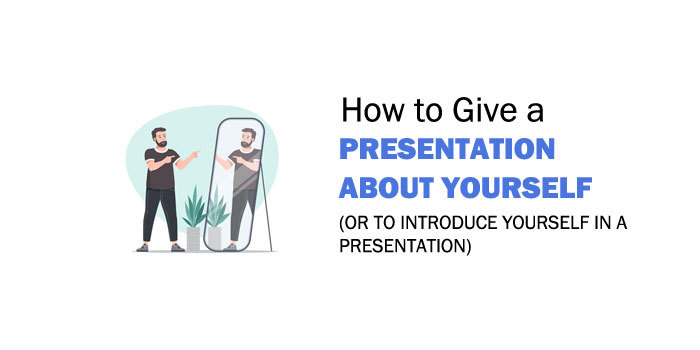
Presentations can be very nerve-racking experiences!
Even seasoned speakers will get the jitters!
When you’re preparing to give a talk about something, you put a lot of time and energy into crafting what you have to say. Understandably, you want things to go as well as possible.
Maybe you’re going to give a speech about an area of expertise that you have in a particular industry.
Perhaps your presentation will to focus on a personal experience that’s had a significant influence on your life.
Then again, you could be getting ready to give a funny speech that you hope will really entertain listeners .
Whatever your presentation is about, your main goal is for those attending your talk to pay attention. Without that, all your blood, sweat and tears − as the saying goes − is for nought!
Giving a Presentation About Yourself
When you introduce yourself at the start of a presentation, it’s the first opportunity that audience members have to meet you formally. So, you should give them the best impression that you can.
It’s critical, at this point, to establish a strong connection with participants that will encourage them to hear you out.
Audiences are known to judge a speaker quite quickly!
The moment you open your mouth, they’re deciding whether they’re going to like what you have to say or if there’s something else they’re rather spend their evening doing.
If it’s the latter, they’ll look for a chance to make a speedy exit as unobtrusively as possible – like when the lights dim so that you can show your first slide, for example.
Here’s how to woo watchers and keep them in their seats with an effective personal introduction.
Start with the Basics
At a minimum, you must tell those listening who you are and what your presentation is about.
If they’ve signed up for the talk, they should know this already. Nevertheless, you need to show them respect by starting off with these few facts.
You never know, someone could be in the wrong meeting room!

In addition, this is the time to pique participants’ interest by briefly saying why it is that you’re giving this particular speech.
Typically, you’ll do this by offering your credentials or a little of your experience on the subject matter.
Here, you can also include a comment about what you hope listeners will learn from you.
You may have heard this approach referred to as the elevator speech or elevator pitch .
In this instance, it’s all about giving people the basic information they need in preparation to hear your speech, and doing it concisely in simple language that everyone will understand.
Here’s a sample:
‘Hello. My name is ___________. I’m a neuroscientist. I’m here to talk about how the body responds to stress and what we can do to improve our stress responses.”
Construct the Connection
Beyond offering the basics, give some thought to how you’d like audience participants to remember you.
This where you must consider how to make the right connection with listeners.
Sure, you want them to think favourably of you but what are the particulars of that good impression?
Can you imagine what they might tell others about your talk?
Do you want them to go away and Google more information about your speech topic ?
Are you interested in having them follow your story on social media?
This will determine what you tell them in addition to your name, rank and serial number, so to speak, and your subject matter expertise.
Here are a few steps that will help:
1. Predict participant profile
For any presentation, you should know who you’re speaking to.
While you can’t be expected to know anything about audience members as individuals, you should be able to get a general sense of them in terms of their demographic and other characteristics.
Say you’re speaking to members of a local club. Find out ahead of time why these folks are members of the same organization.
Are most of them retired and looking for a social outlet? Is the club focused on providing a service to the immediate community, or doing good works oversees?
Try to develop a loose idea in your mind of what the participants have in common.
2. Think like listeners
As much as possible, try to put yourself in the shoes of the people coming to hear your presentation.
Be very careful not to generalize or assume too much based on what you understand connects them as a group.
Just use what you know as a helpful yard stick to gauge what you can say about yourself that might resonate with them – or with the majority.

Maybe you’re giving a talk about how to achieve financial success, and your audience is all 20 somethings struggling to pay off student debt while juggling a few jobs in the gig economy.
Certainly, you should introduce yourself with regard to your financial expertise. However, you’ll make a stronger impact on them if you can relate to being a starving student once yourself.
They need to get that you know what you’re talking in both respects and what you’re going to tell them will be valuable.
3. Use universal understanding
Regardless of the diversity in your audience and how they may differ from you, there are some day-to-day life events that most of us can connect with.
Use this common appreciation to create empathy in your self introduction .
You might be able to bond early on with participants by mentioning interpersonal relationships, traffic jams, work challenges or inclement weather, for instance.
When you can offer something else about yourself in this way, it will enhance the connection between you and your listeners.
Succinctly explaining your back story, or your personal perspective, as it relates to your topic will grow your credibility.
“Hello. My name is ____________. I’m a family therapist. When I was a child, I had a sibling that suffered from mental health problems and that’s why I became a therapist. I’m here today to tell you how we can strengthen and heal relationships with others.”
Putting it All Together
There are a few terms you may hear that sum up putting these pieces together to introduce yourself.
It’s called the Rhetorical Triangle or the Triangle of Trust. Simply put, it’s about connecting yourself to the message and then connecting your message with the audience.
It may be easier to remember if you can visualize a triangle with three points – speaker, message, audience.

This demonstrates the importance of speaking from one’s knowledge base, presenting the message logically and appealing to the audience’s emotion.
It reinforces that people are more likely to listen to and connect with you when you appear to know what you’re talking about and have a passion for the subject matter.
You might also like: Preparation: How to write a Speech Outline (with Examples)
6 Ways to Work your Introduction Magic
Once you’ve got a good idea of what you want to say about yourself in your presentation, it’s time to fine tune your plan. Here are several tips to make your personal intro really pop!
1. Communicate clearly
It shouldn’t surprise to you that you need to speak at a reasonable volume and enunciate your words clearly.
A successful speech starts out strong .
Therefore, when you’re telling listeners who you are and a bit about you this is the place to practice communicating properly.
You may feel reluctant to ‘toot your own horn’ but the audience needs to know a little about you and also how to say your name correctly.
So, speak up !

If your name might be a difficult one for some participants to pronounce, take the time to walk them through. Here are two illustrations:
“Hello. My name is Adeolu Akomah. That’s pronounced “ad – e – o – lu – a – kom – ah”.”
“Hello. My name is Ryan Trench. That’s pronounced the same way as in “trench coat”.”
2. Make it natural
As much as possible, put your nervousness aside and try to be yourself.
In other words, show your personality sincerely and don’t try to present an image of someone that you’re not.
We can be forgiven for watching other presenters and thinking that they’re more compelling speakers or have a special charisma.
This may definitely be the case, but how do you think most of them became this way?
It’s because they learned to be comfortable in their own skin when giving speeches.
We each have a unique personality and one key to connecting with an audience is to show that when introducing yourself.
3. Set the tone
Building on the previous point, set the proper tone for your talk.
Will it be a quite formal presentation about a serious subject?
Or, is it going to be an entertaining personal story where you want participants to feel a little laid-back and not restrain their laughter at the right moments?
Try to match the emotion in your voice to the purpose of your presentation.

There’s nothing wrong with speaking in grave thoughtful tones when you want to pull on people’s heart strings with a serious subject matter like childhood cancer.
By the same token, letting a few chuckles escape when you introduce why you’re an expert on skiing mishaps can also stage an appropriate mood.
Setting the tone also means being polite and showing participants that you appreciate their attendance. Acknowledge them with a short welcome or thank them for coming.
4. Bring best body language
Body language is a critical component of giving any speech.
During your personal introduction, your body language can help to build trust or cast doubt on your words.
Strive to appear relaxed and confident
Listeners will then be more apt to believe that you are who you say you are and that you have something to tell them that’s worthy of their time and attention.
5. Watch for TMI
This is a trickly one!
TMI, or too much information, is generally a judgement call based on the aim of your presentation.
So, how much is too much?
Well, you mustn’t offer your whole life story! Just zero in on the relevant details that are necessary to set the stage for your speech.

We’re all complex individuals with varied and interesting backgrounds and life situations. Your audience gets that but they want to know what’s drawn you to speak to them today.
As already touched upon, how to describe yourself as an expert is critical.
It’s okay to be humble but remember that you need people to understand that you know your subject matter so give them enough to go on.
6. Strategize with stereotypes
‘No two ways about it, your audience is bound to stereotype you when they hear a bit of your background.
There are two methods to use this to your advantage.
First, you can capitalise on the typical stereotype and reinforce it with some self-deprecating humour. Maybe you want to play up being a science geek.
Alternatively, you can turn the stereotype on it’s head by introducing yourself as an atypical example of what listeners may be assuming when they hear your background.
Say you’re a grandmother who is giving a talk about saving the environment. If you’ve sailed solo across an ocean, weave that into your introduction as it relates to your passion for ecology.
Whatever you choose, think of what works best to connect with your audience.
Try Out Toastmasters
Here’s another approach to learning the fine points about introducing yourself in a presentation – learn from Toastmasters International .
If you’re not familiar with this organization, essentially, they’re a club where people meet regularly to study and practice public speaking and leadership skills.
Plan to drop in at a meeting as a visitor when someone is giving a talk, or watch online videos of members presenting.
These are two ways to observe how people apply what they learn through Toastmasters to give a great introduction about themselves.

The other choice is to read up on the first speaking project that all Toastmasters members take on.
This is called the Icebreaker speech . The objective is for presenters to give a short talk about themselves so that other members can get to know them.
Of course, this is definitely a different type of speech !
Having said that, the Icebreaker lesson reinforces that you can choose what exactly you want people to know about you, and its good practice for getting comfortable talking about yourself.
The guidance given is to say something about your life experience, your occupation, what you spend your time doing and/or your family.
People love personal stories so no matter what you choose to tell them about yourself, they’re bound to find it interesting and probably will notice several points of connection they have with you.
What’s more, even if you’re not a member of Toastmasters International , you can access the Icebreaker speech instructions free online.
If you do decide to delve further into Toastmasters, you never know, you might quickly get hooked!
Related: What to Expect at Your First Toastmasters Meeting
Conclusion: Giving about Presentation About Yourself
How you introduce yourself when giving a presentation can make all the difference.
Be mindful that the start of your talk is when you have a captive audience.
And, make sure you use that edge to intrigue them and then make a smooth transition to the content of your speech.
By following a few pointers about the best way to introduce yourself, you’ll leave listeners with an immensely memorable experience!

20+ Self Introduction PowerPoint Templates: Download for free!

Think about the image you want to portray during your presentation pitch. Creativity? Soberness? Reliability? A professional PowerPoint design can help you deliver a powerful introduction to your stakeholders .
Here, you'll find some creative Self-Introduction PowerPoint Templates that are going to elevate your slides to the next level. Our expert team has designed different layouts that you will surely love and save you a lot of time.
And if you want to present your company and highlight your team's experience, you'll also find some fantastic Team Presentation Templates . Keep reading to get them all for free!

Introducing Yourself PowerPoint Templates
Introducing yourself is vital to generate a connection with your audience . In fact, it showcases your background and abilities, making sure you are the person they seek.
That being said, let's have a look at the Self-Introduction PowerPoint Templates that we prepared for you and will optimize your creative process:
1. About Me PowerPoint Template
These self-introduction PowerPoint templates are perfect for anyone trying to convey sobriety and professionalism.
The pack offers different layouts, which you can use to engage your audience and showcase your work experience.
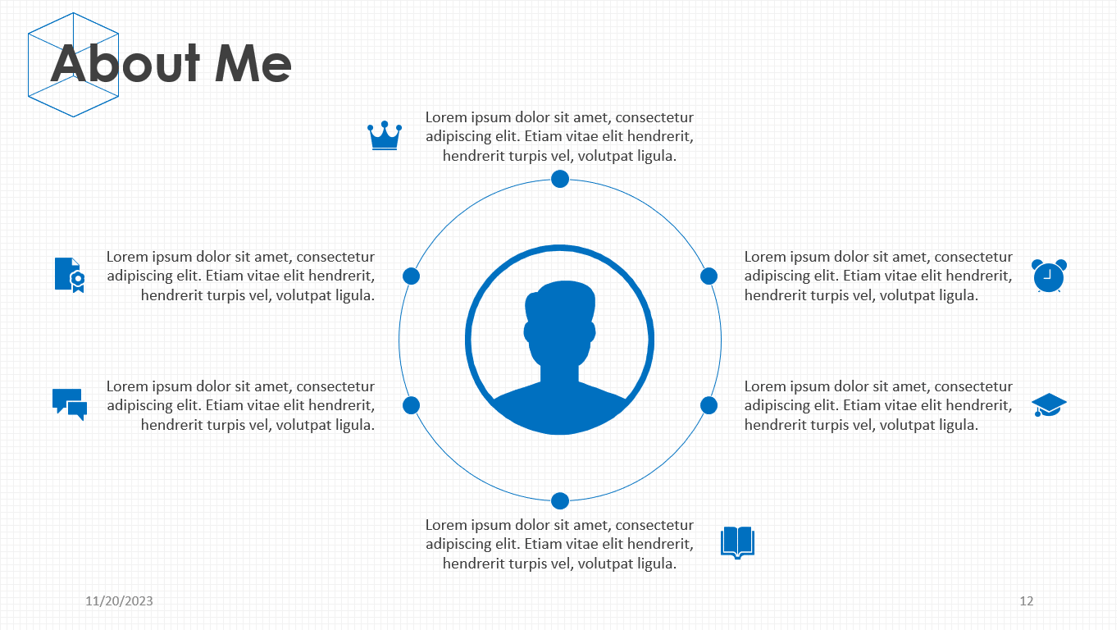
2. Personal Resume PowerPoint Template
This template is another great option for introducing yourself through a PowerPoint presentation.
You'll find different types of diagrams and graphs that will display all your skills and work experience in a more eye-catching way.
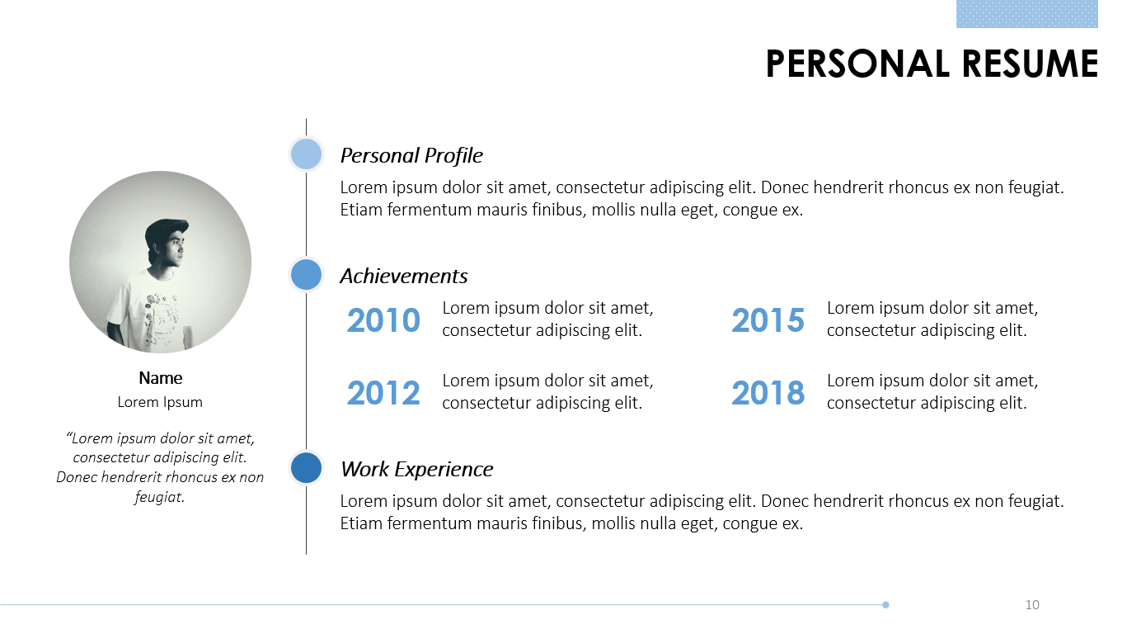
3. Colorful Resume PowerPoint Template
With this colorful template, you'll be able to create more impactful slides and add your desired background.
It also includes a map that will help you showcase your experience abroad!
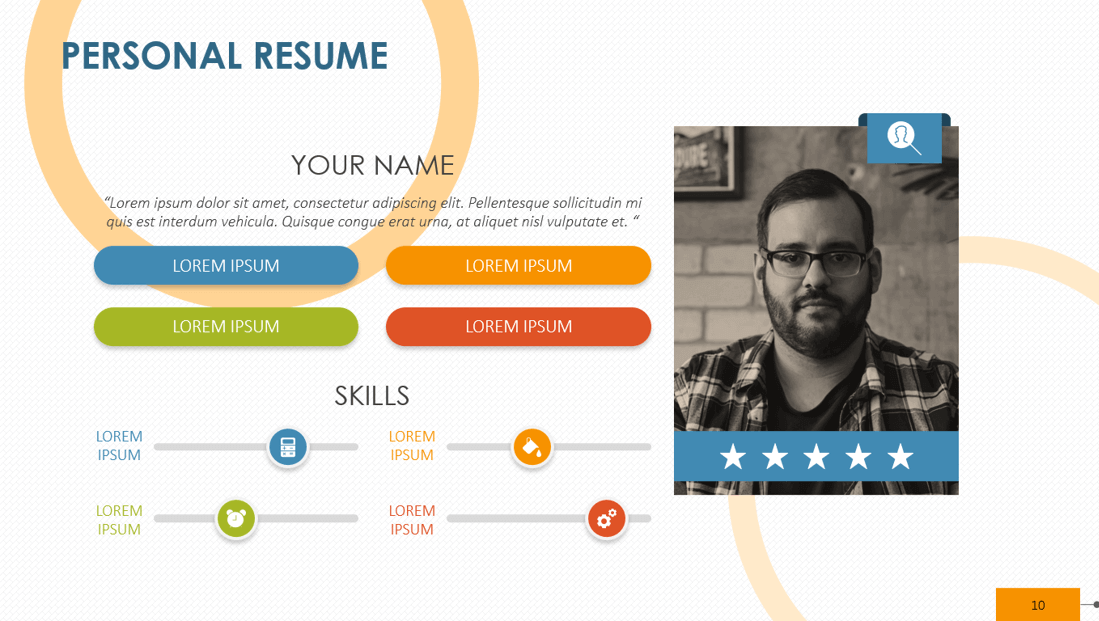
4. Creative Resume PowerPoint Template
If you are not sure of the color palette of your presentation, try this blue template. It's the perfect color to convey professionalism!
This self-introduction PowerPoint template will definitely catch your audience's attention from the beginning.
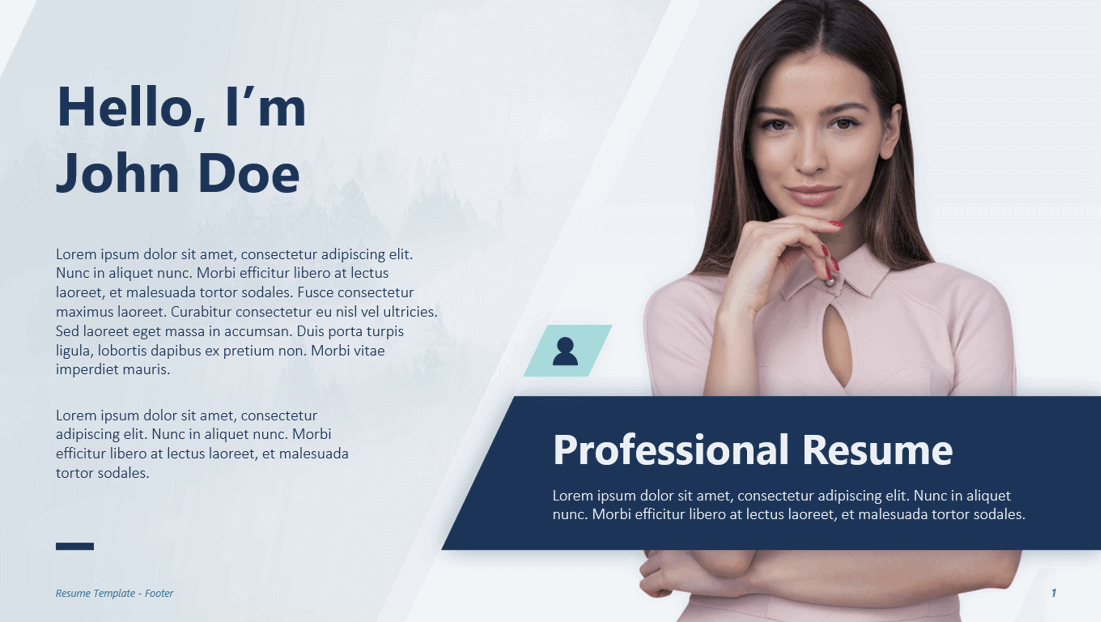
5. Personal Branding PowerPoint Template
This template is focused on Personal Branding, but you can use the graphics to organize your "About me" presentation in PowerPoint.
As always, we invite you to customize each element however you like!
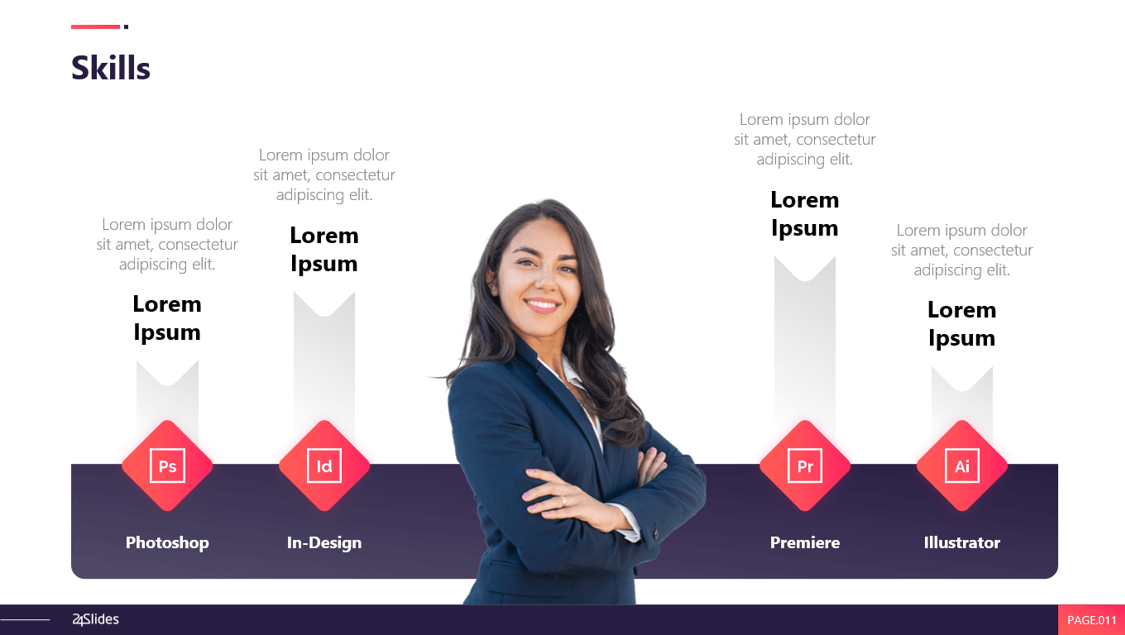
6. Women Leadership Powerpoint Template
Want to be concise in your pitch? This template will inspire you!
As you can see in the image, you'll find a minimalist design of pink and purple tones.
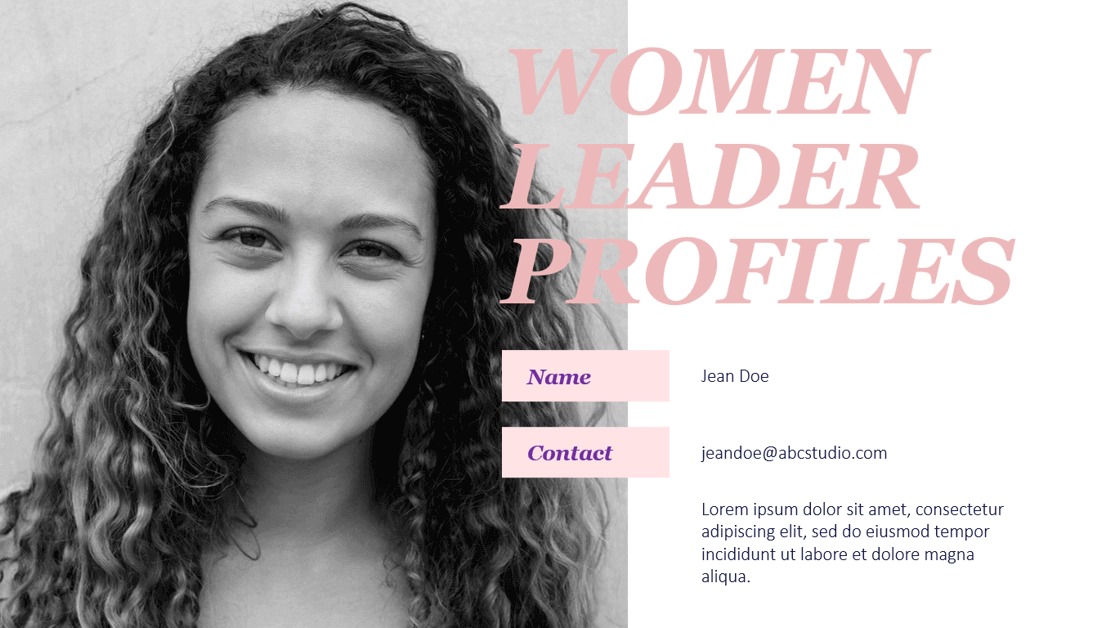
7. Timeline Infographic PowerPoint Template
This template package has timelines and graphics that will be useful for organizing your personal information.
If you were looking for a modern and creative self-introduction template, this design may be for you!
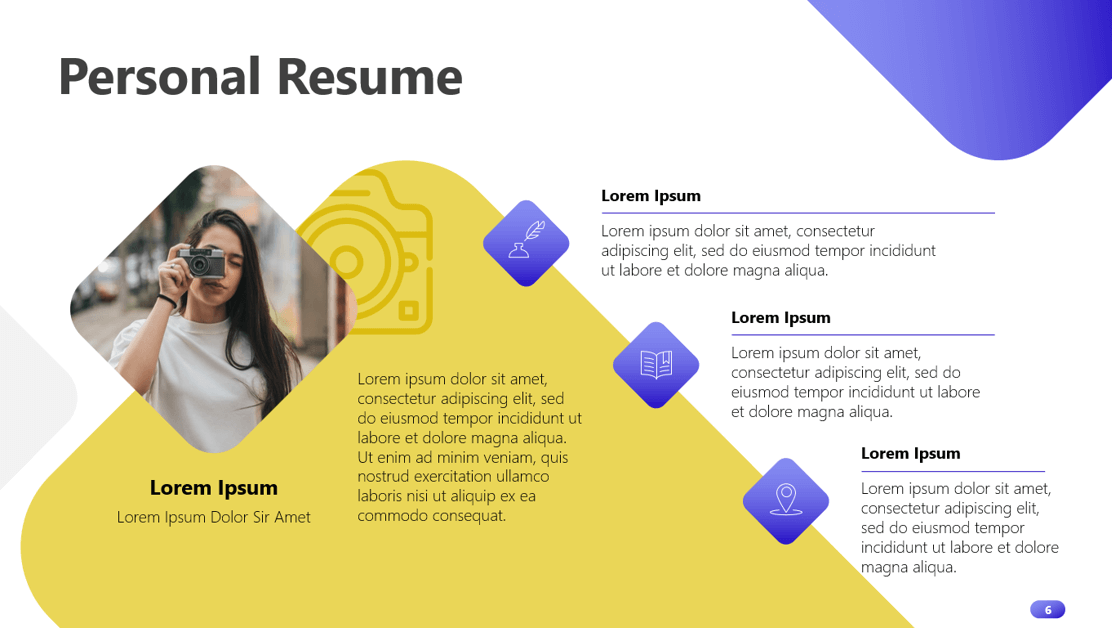
8. User Persona PowerPoint Template
This PowerPoint template was initially designed to present Buyer Personas but can be adapted for an "About Me" section.
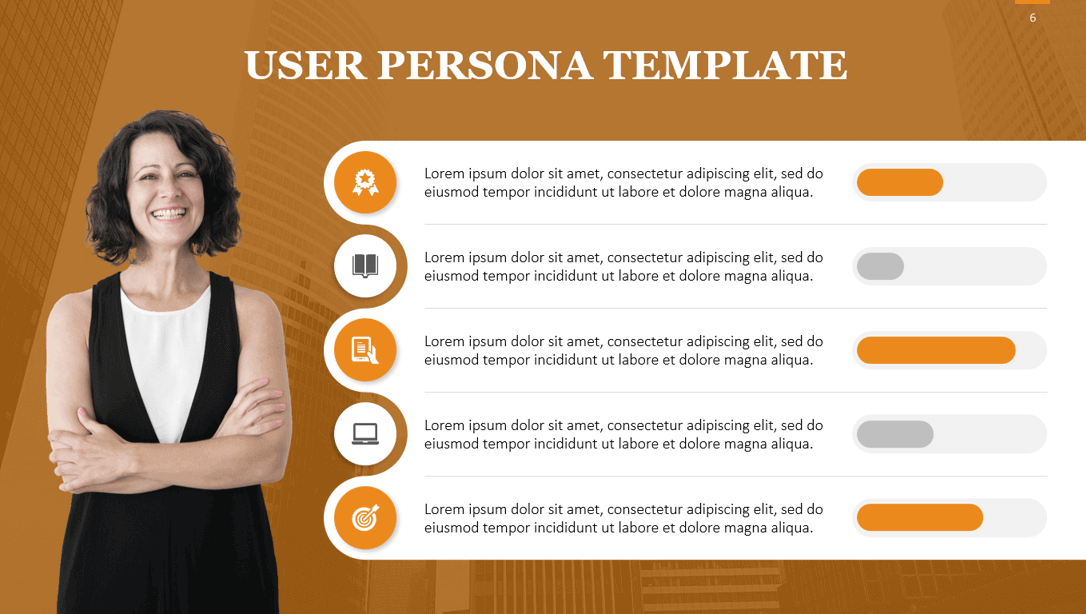
9. Photography Portfolio PowerPoint Template
Want to improve your portfolio? We've designed portfolio templates in PowerPoint, too!
This resource was created for photographers, but you can adjust it to your needs.
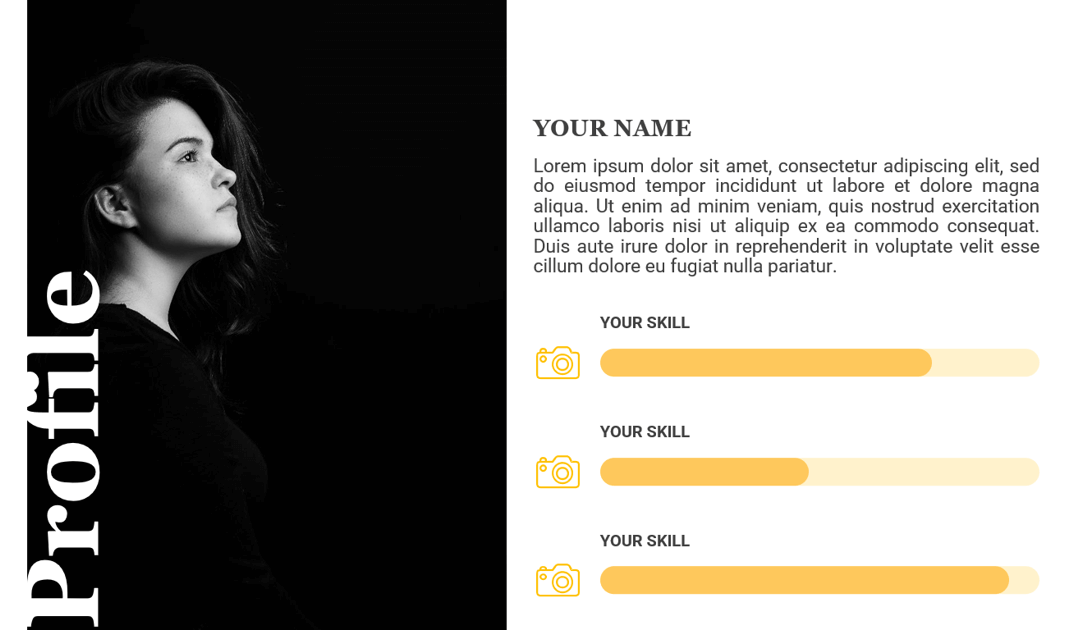
10. Career Portfolio PowerPoint Template
Here is another portfolio design in PowerPoint!
When you download this template, you'll find a sober self-introduction design with blue tones.
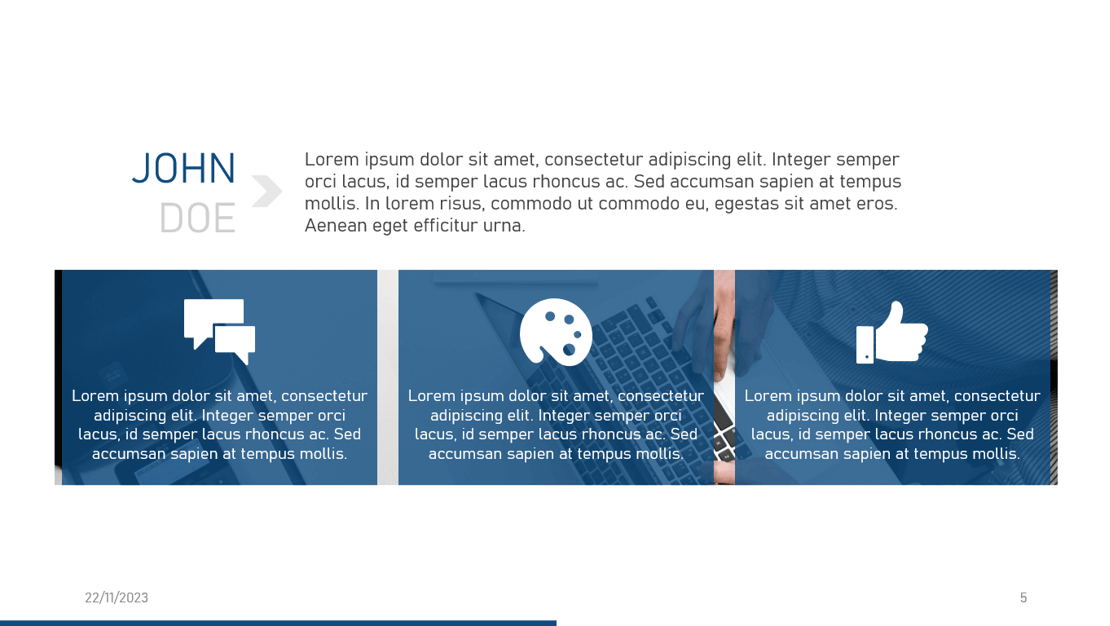
We're not done yet!
In the following section, you'll discover more PowerPoint templates for introducing your work team to an audience.
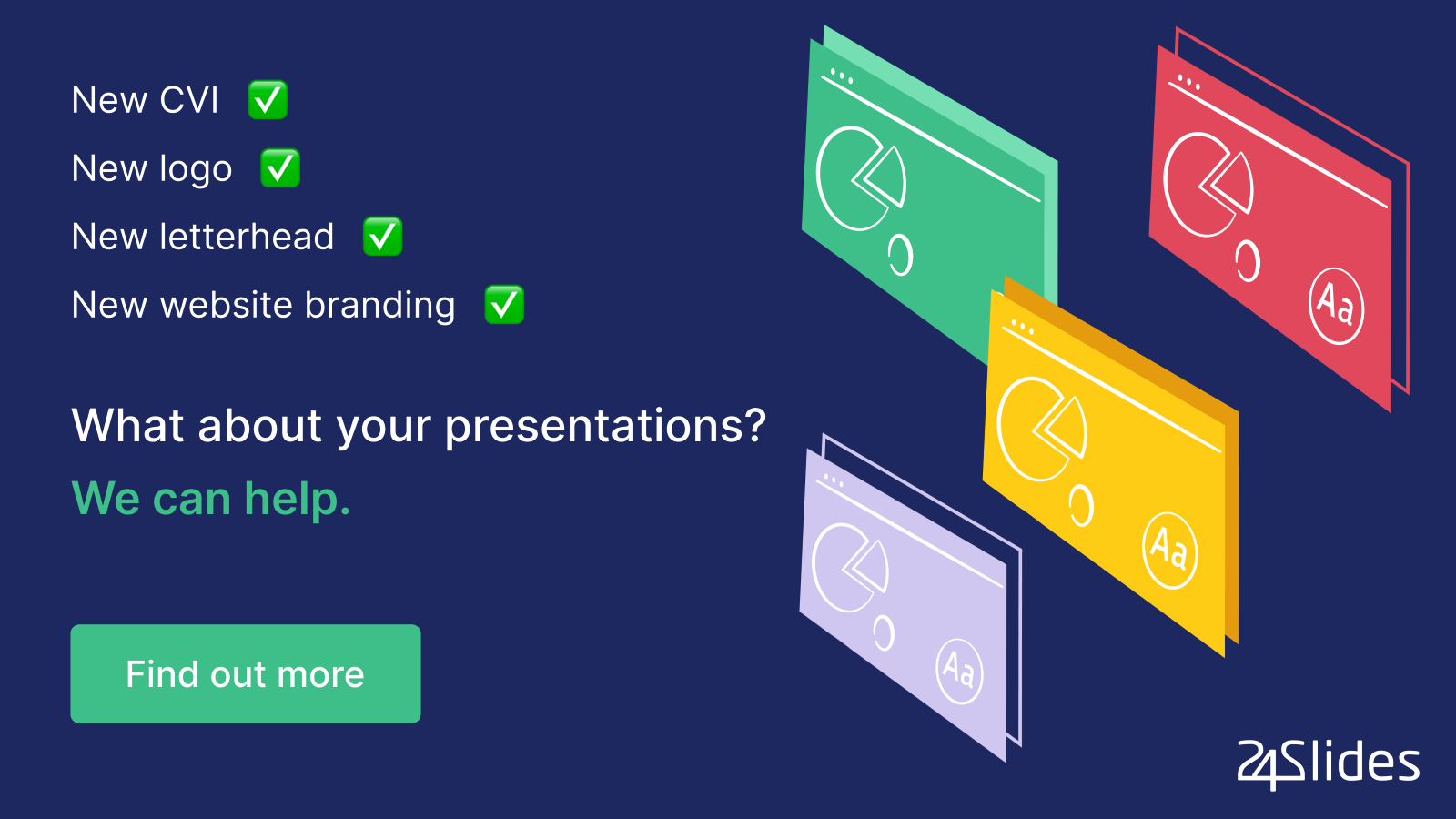
Team Introduction PowerPoint Templates
Introducing your team becomes crucial when you want to attract new clients or investors to your business. It will spotlight your team's capabilities, convincing your audience that you can solve their problems.
As always, all the slides in our templates are easily editable , so you can add any image you like and customize the aesthetics according to your color scheme .
Let's check the Team Introduction PowerPoint Templates we have for you:
1. Team Slides PowerPoint Template
This team introduction PowerPoint template offers 8 different designs that will impress your audience.
Pick the layout you like the most and add it to your presentation deck!
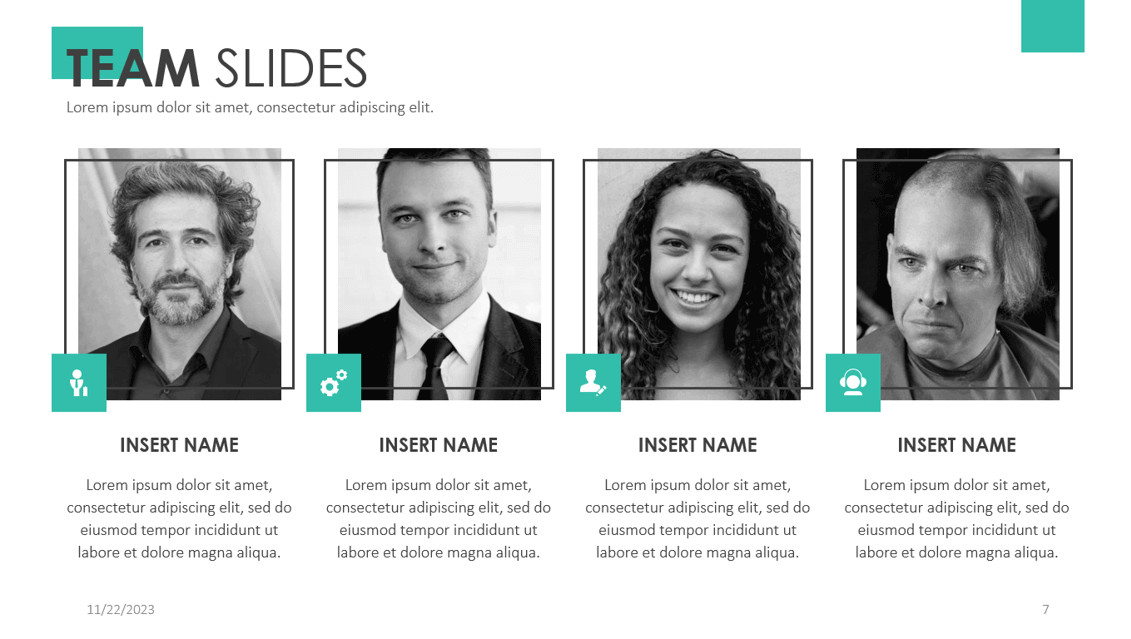
2 . Roles and Responsibilities PowerPoint Template
This PowerPoint template is all about the roles and responsibilities of each team member.
If you’re working on a new project, this team intro PowerPoint template will be perfect!
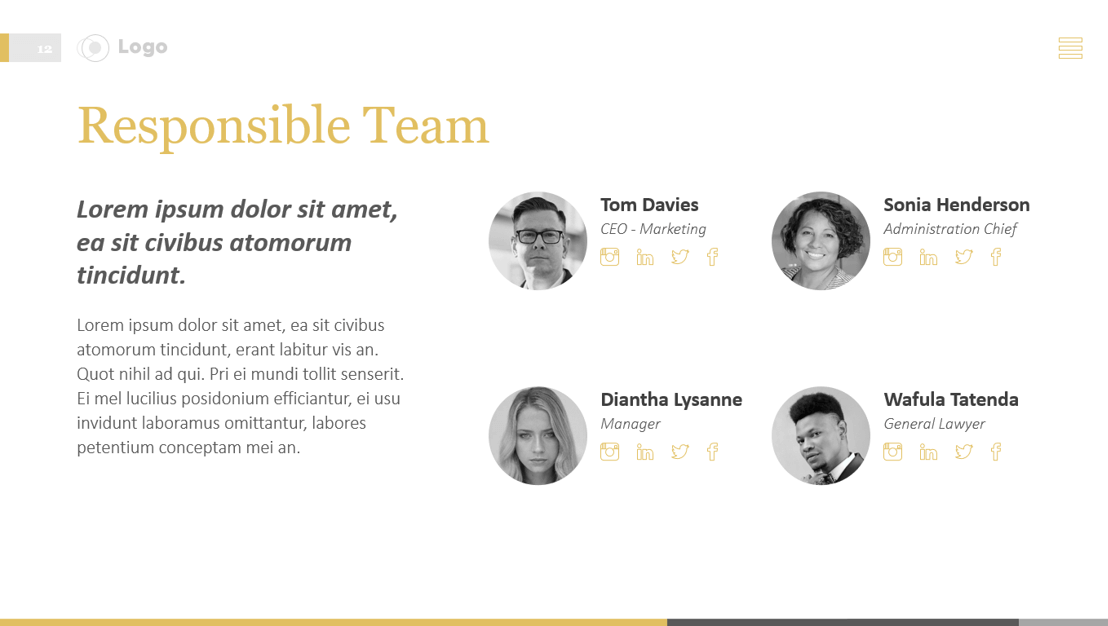
3. Meet The Team PowerPoint Template
If you're seeking to introduce your company to a potential investor or client, check out these team introduction slides!
This template pack will help you to present a complete overview of your business and the people involved in it.
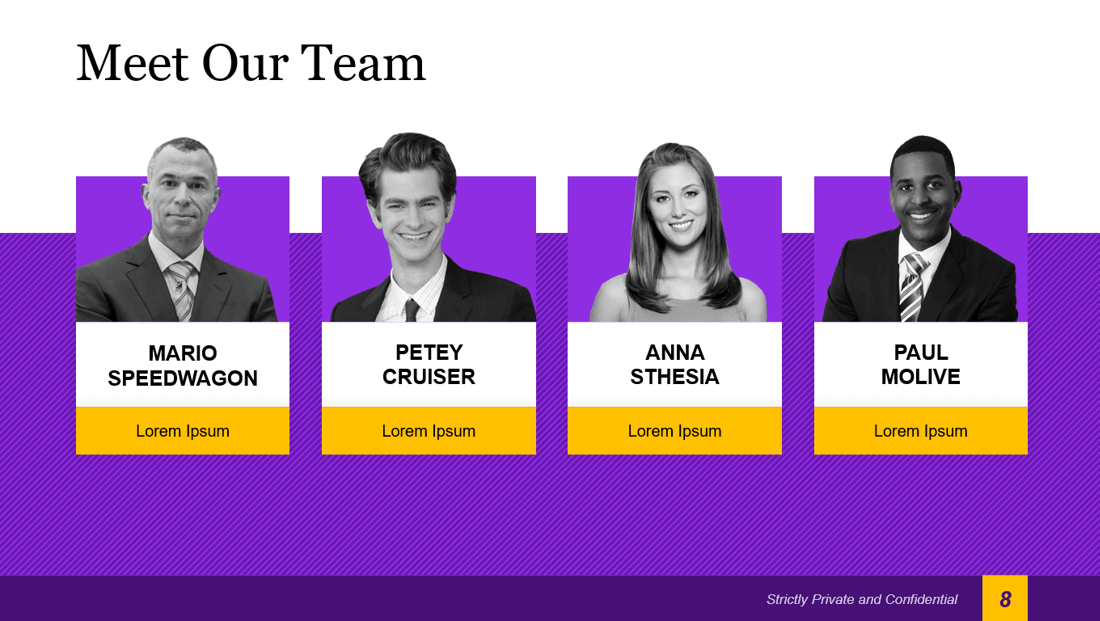
4. Project Management PowerPoint Template
Do you have a project running and need to design the final presentation? This template is made for you!
As in the previous designs, you will find a project team slide template and more graphics that will make your presentation dazzle.

5. Strategic Action Plan PowerPoint Template
Here is another of our corporate templates to introduce your work team to an audience.
If you want designs with green and blue tones, this resource is for you!
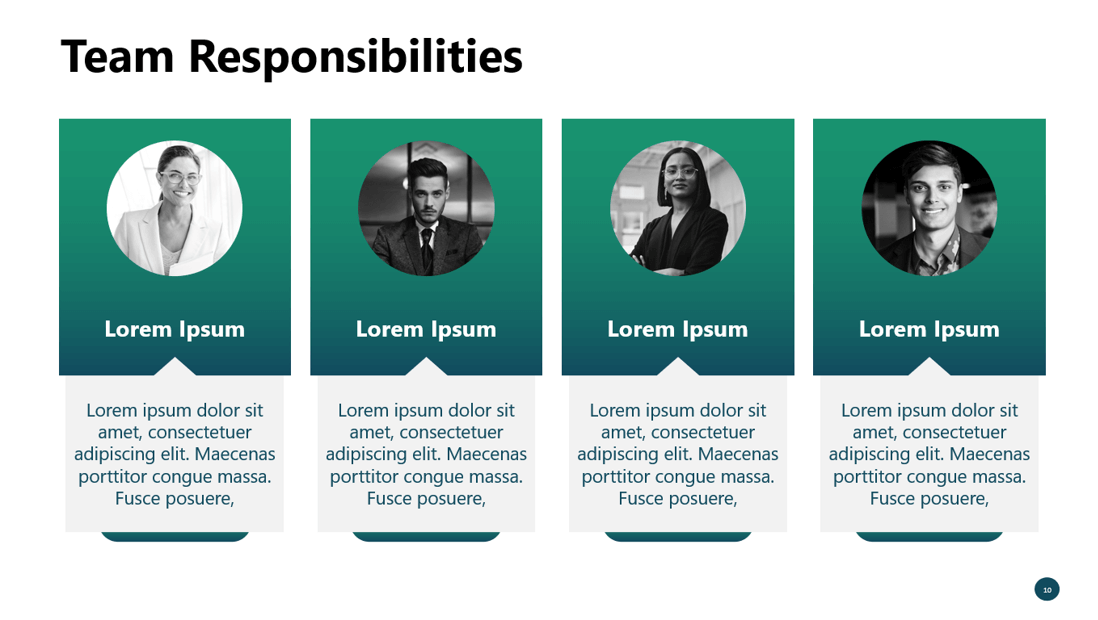
6. Finance Team PowerPoint Template
This presentation contains animated slides with a fresh design.
When you download this PowerPoint template, you'll find a "mission and vision" section, a description of services, a customer profile, and more!
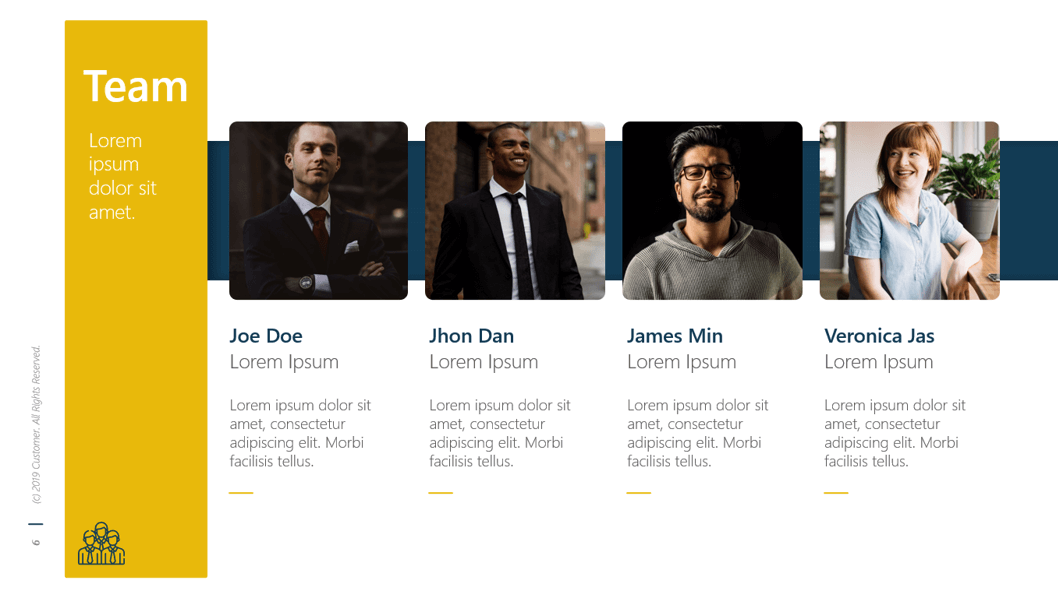
7. Light Corporate PowerPoint Template
Want to present a creative self-introduction but need more time to think about the design? If so, this template will be perfect for you.
You'll find a "meet the team" section, 3D graphics, infographics, and more. Download it for free now!
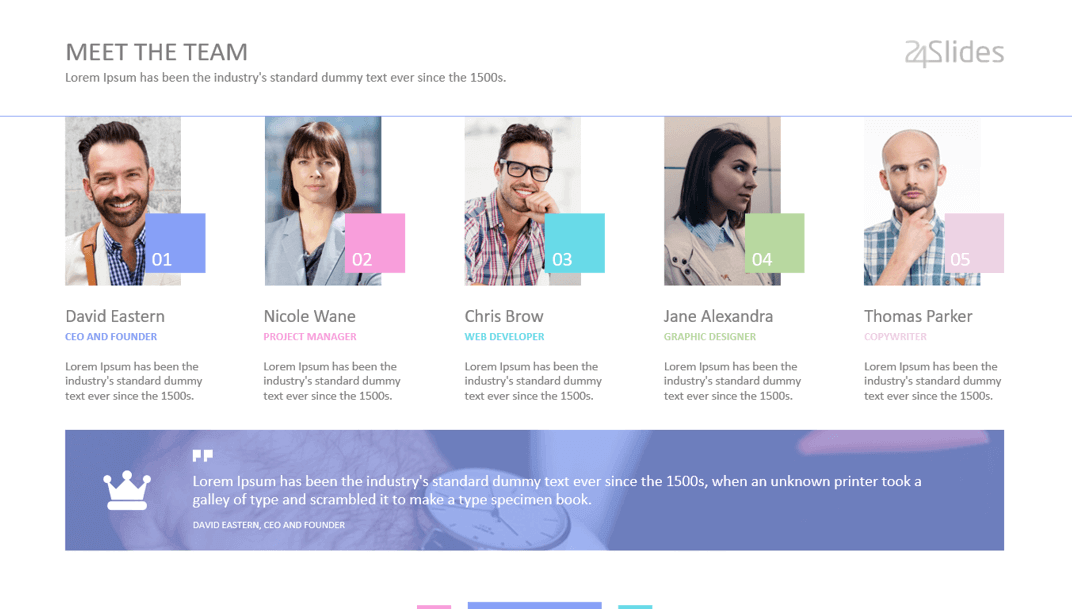
8. Creative Business PowerPoint Template
If you prefer a one-page self-introduction, take a look at this template.
It contains icons, timelines, statistical graphs, and more resources. Like the previous designs, the download is completely free!
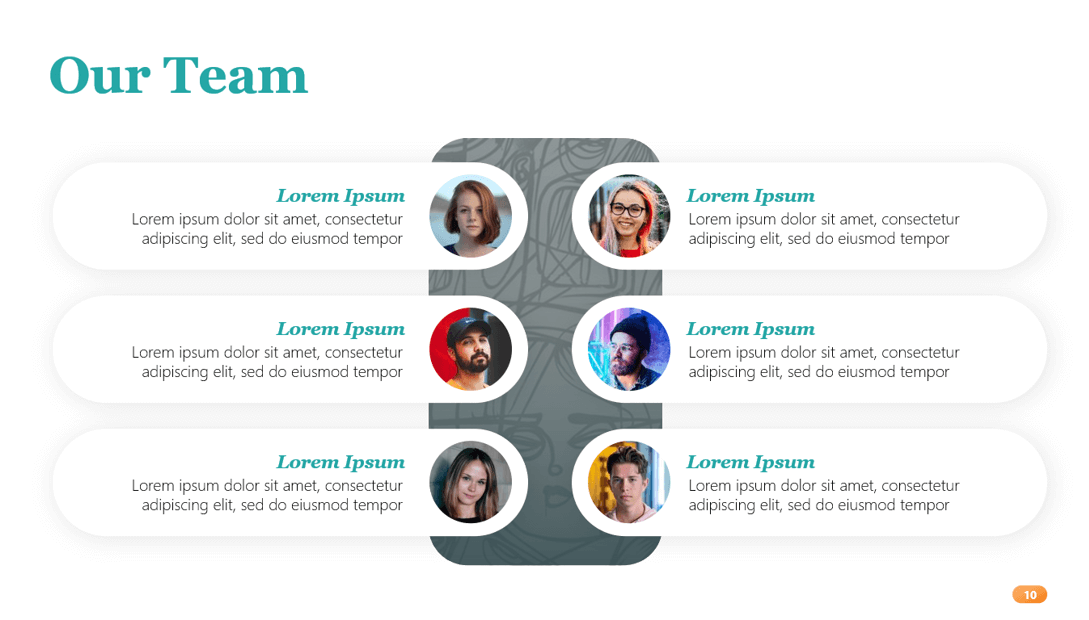
9. Creative Pitchbook PowerPoint Template
This PowerPoint template and its unique designs will immediately catch your audience's attention.
If you want to convey professionalism and detail-oriented, this template pack is for you.
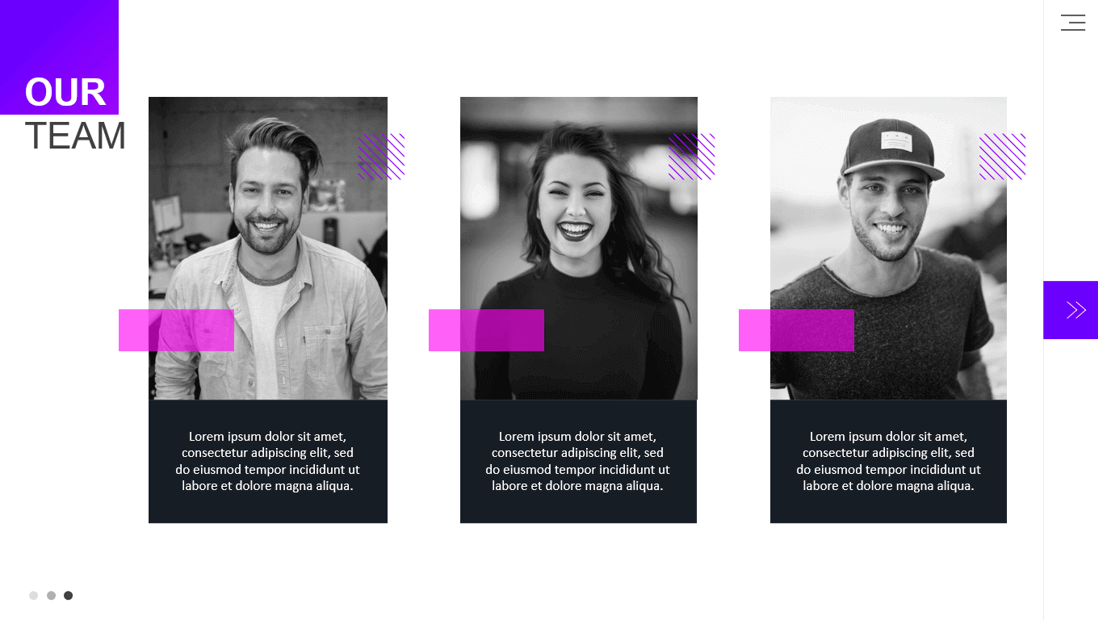
10. Film Pitch PowerPoint Template
These designs were created for film teams but can be adapted to any field!
We are confident its aesthetics will inspire you.
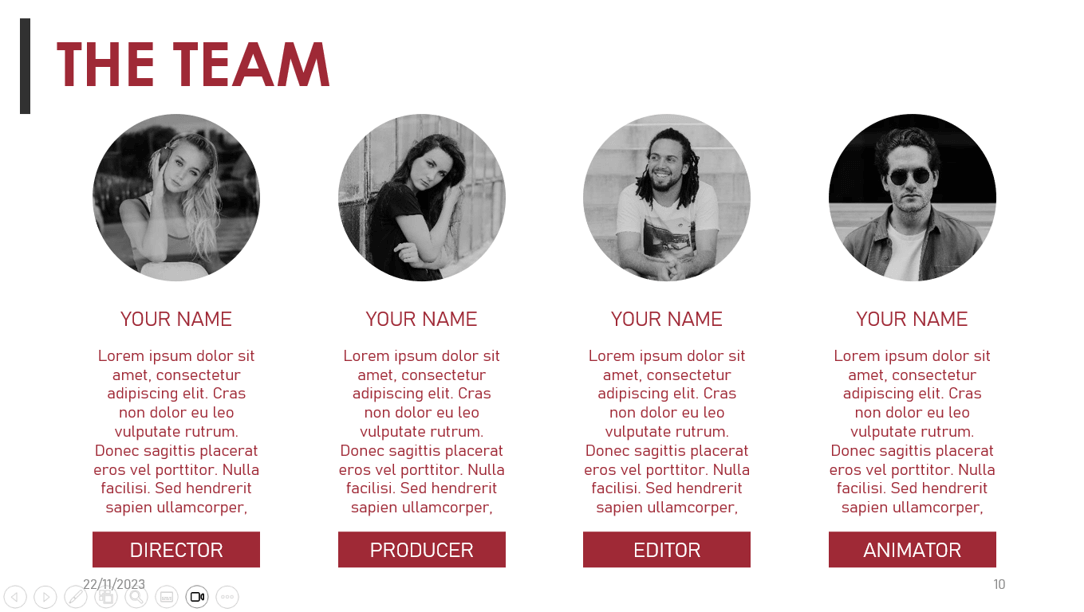
11. Storyboard Artist PowerPoint Template
Looking for more creative self-introduction slides? You'll love this one!
Initially, this template is black and white, but you can edit the colors freely.
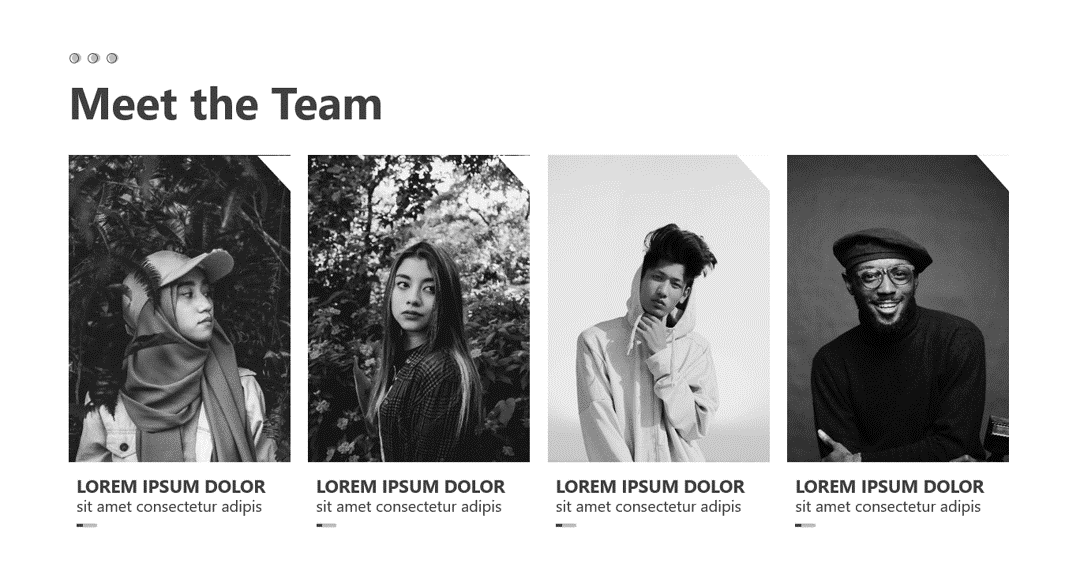
12. Team Introduction PowerPoint Template
This team introduction PowerPoint template has a unique format.
You'll be able to highlight your team's skills visually. And the best thing is that it's easy to understand at first glance!
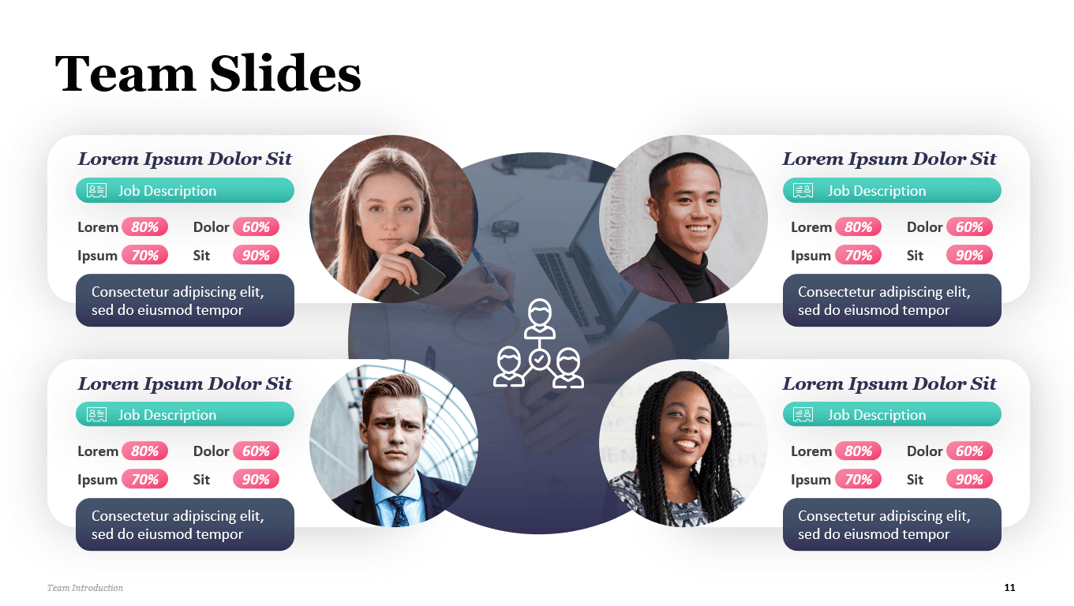
13. Science Organization PowerPoint Template
A team introduction is always a great idea, but it's even better when you can showcase the relationship between different members and roles!
With this template pack, you can make that possible.
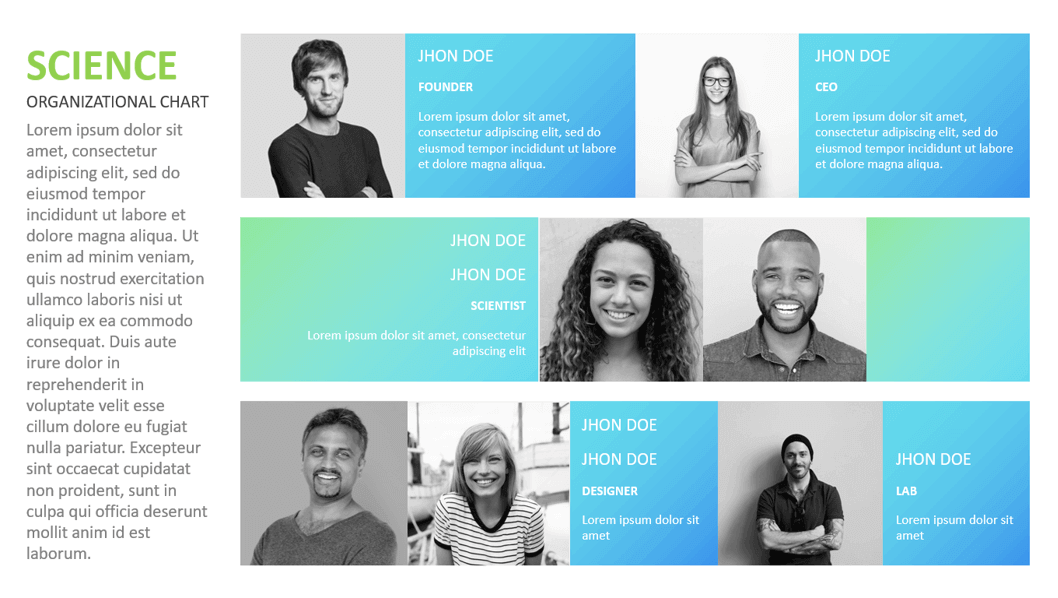
Looking for Custom PowerPoint Presentations? We got you!
If you liked our free template designs, you'll love 24Slides custom presentations !
A PowerPoint presentation is a great place to start making an excellent first impression. It will show your audience how committed you are to a project and how much effort you will put into it.
But making a good PowerPoint presentation takes a lot of time and effort. Why not call upon professionals to handle it efficiently?
24Slides offers a pro-level design service that will elevate all your presentation decks. Our Designers have worked with some of the biggest companies worldwide, so we can offer the expertise you need.
Still not sure? While working alongside us, you will:
- Own high-impact presentations aligned with your brand – We help you communicate the message you want to convey!
- Choose between different services: Regular Service , Dedicated Design Teams , and Credit Packages – We adapt to your needs!
- Manage fast turnarounds – Go rest and get your presentation the following morning!
- Enjoy the process since we guarantee the confidentiality of your data – Your information is in good hands!
- Have the option to create a platform for connecting your Internal Team with our Designers – The integration will be seamless!
The best part is that you can try our expertise and style for just $1 . Our Designers will be happy to show you the true potential of your slides!
Found this content interesting? You'll love what's next:
- Learn How to Start a Sales Presentation
- 36 Fun Icebreakers for Your Next Presentation
- Why is Brand Identity Important in Presentations? Experts answered!
- The Cost of PowerPoint Presentations: Discover the hidden expenses you might overlook!
Create professional presentations online
Other people also read
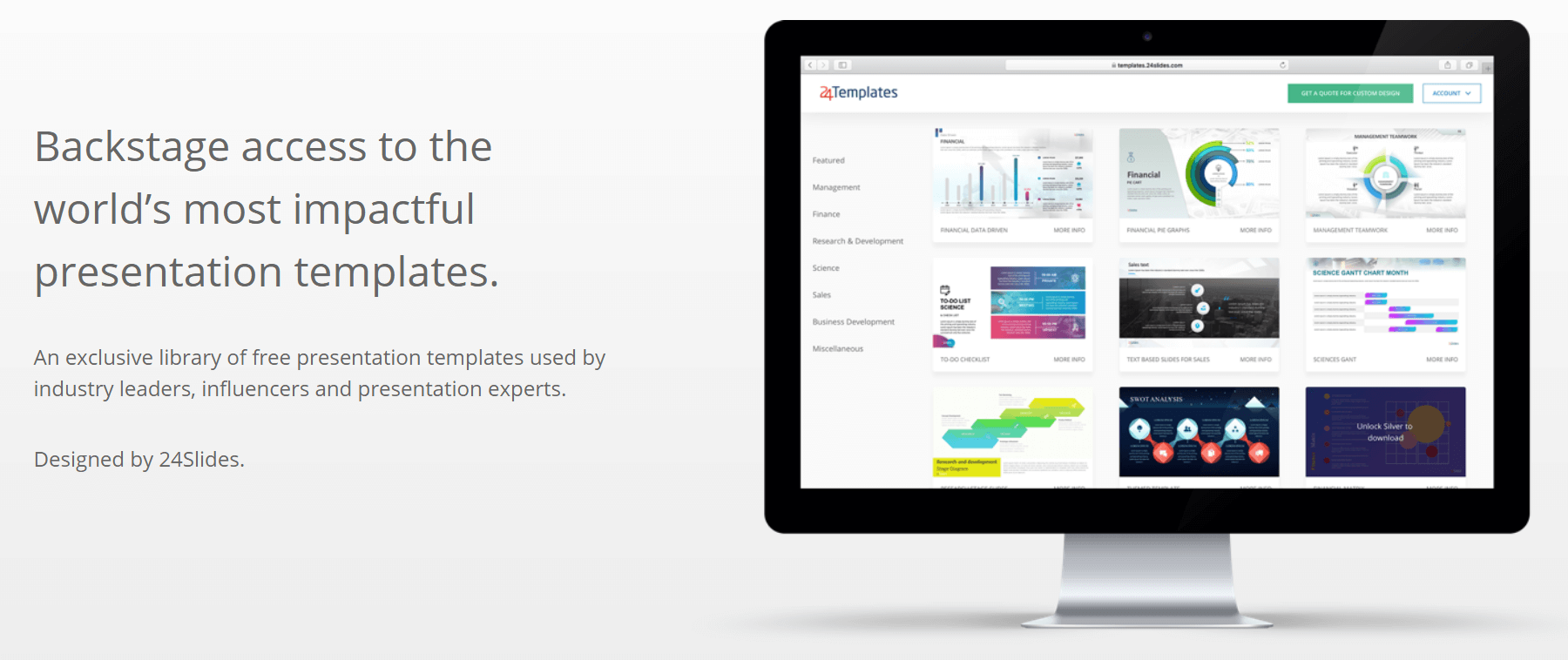
The Best Free PowerPoint Presentation Templates You Will Eve...

Blue Ocean Strategy PowerPoint Templates
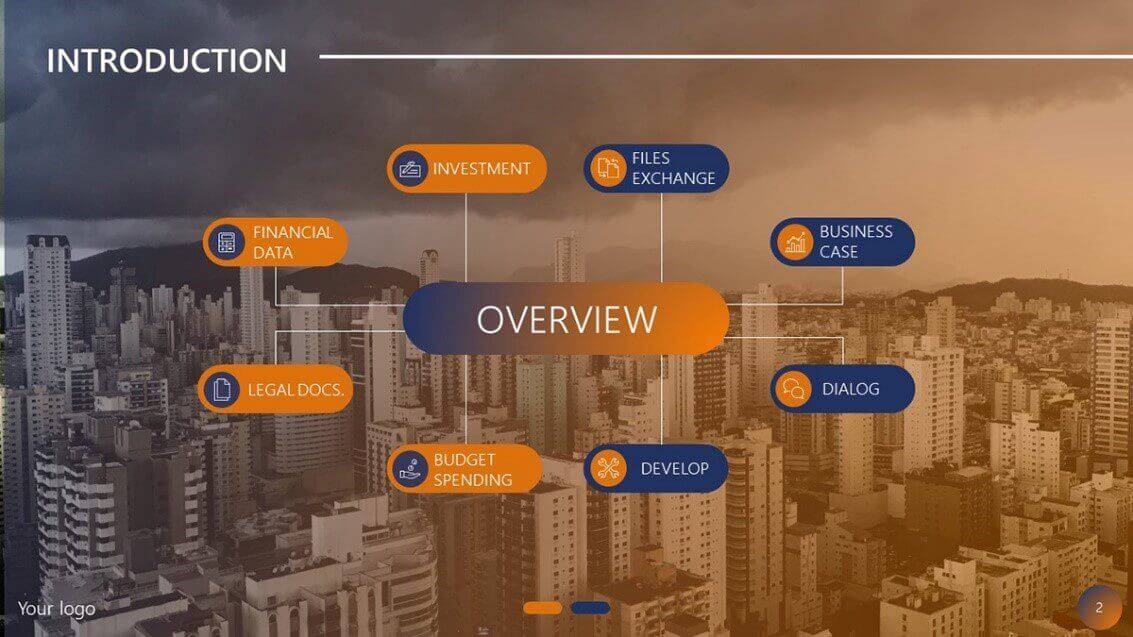
Our Most Popular Free PowerPoint Templates

How it works
Transform your enterprise with the scalable mindsets, skills, & behavior change that drive performance.
Explore how BetterUp connects to your core business systems.
We pair AI with the latest in human-centered coaching to drive powerful, lasting learning and behavior change.
Build leaders that accelerate team performance and engagement.
Unlock performance potential at scale with AI-powered curated growth journeys.
Build resilience, well-being and agility to drive performance across your entire enterprise.
Transform your business, starting with your sales leaders.
Unlock business impact from the top with executive coaching.
Foster a culture of inclusion and belonging.
Accelerate the performance and potential of your agencies and employees.
See how innovative organizations use BetterUp to build a thriving workforce.
Discover how BetterUp measurably impacts key business outcomes for organizations like yours.
A demo is the first step to transforming your business. Meet with us to develop a plan for attaining your goals.

- What is coaching?
Learn how 1:1 coaching works, who its for, and if it's right for you.
Accelerate your personal and professional growth with the expert guidance of a BetterUp Coach.
Types of Coaching
Navigate career transitions, accelerate your professional growth, and achieve your career goals with expert coaching.
Enhance your communication skills for better personal and professional relationships, with tailored coaching that focuses on your needs.
Find balance, resilience, and well-being in all areas of your life with holistic coaching designed to empower you.
Discover your perfect match : Take our 5-minute assessment and let us pair you with one of our top Coaches tailored just for you.

Research, expert insights, and resources to develop courageous leaders within your organization.
Best practices, research, and tools to fuel individual and business growth.
View on-demand BetterUp events and learn about upcoming live discussions.
The latest insights and ideas for building a high-performing workplace.
- BetterUp Briefing
The online magazine that helps you understand tomorrow's workforce trends, today.
Innovative research featured in peer-reviewed journals, press, and more.
Founded in 2022 to deepen the understanding of the intersection of well-being, purpose, and performance
We're on a mission to help everyone live with clarity, purpose, and passion.
Join us and create impactful change.
Read the buzz about BetterUp.
Meet the leadership that's passionate about empowering your workforce.

For Business
For Individuals
The self presentation theory and how to present your best self

Jump to section
What does self presentation mean?
What are self presentation goals, individual differences and self presentation.
How can you make the most of the self presentation theory at work?
We all want others to see us as confident, competent, and likeable — even if we don’t necessarily feel that way all the time. In fact, we make dozens of decisions every day — whether consciously or unconsciously — to get people to see us as we want to be seen. But is this kind of self presentation dishonest? Shouldn’t we just be ourselves?
Success requires interacting with other people. We can’t control the other side of those interactions. But we can think about how the other person might see us and make choices about what we want to convey.
Self presentation is any behavior or action made with the intention to influence or change how other people see you. Anytime we're trying to get people to think of us a certain way, it's an act of self presentation. Generally speaking, we work to present ourselves as favorably as possible. What that means can vary depending on the situation and the other person.
Although at first glance this may seem disingenuous, we all engage in self-presentation. We want to make sure that we show up in a way that not only makes us look good, but makes us feel good about ourselves.
Early research on self presentation focused on narcissism and sociopathy, and how people might use the impression others have of them to manipulate others for their benefit. However, self presentation and manipulation are distinct. After all, managing the way others see us works for their benefit as well as ours.
Imagine, for example, a friend was complaining to you about a tough time they were having at work . You may want to show up as a compassionate person. However, it also benefits your friend — they feel heard and able to express what is bothering them when you appear to be present, attentive, and considerate of their feelings. In this case, you’d be conscious of projecting a caring image, even if your mind was elsewhere, because you value the relationship and your friend’s experience.
To some extent, every aspect of our lives depends on successful self-presentation. We want our families to feel that we are worthy of attention and love. We present ourselves as studious and responsible to our teachers. We want to seem fun and interesting at a party, and confident at networking events. Even landing a job depends on you convincing the interviewer that you are the best person for the role.
There are three main reasons why people engage in self presentation:
Tangible or social benefits:
In order to achieve the results we want, it often requires that we behave a certain way. In other words, certain behaviors are desirable in certain situations. Matching our behavior to the circumstances can help us connect to others, develop a sense of belonging , and attune to the needs and feelings of others.
Example: Michelle is a new manager . At her first leadership meeting, someone makes a joke that she doesn’t quite get. When everyone else laughs, she smiles, even though she’s not sure why.
By laughing along with the joke, Michelle is trying to fit in and appear “in the know.” Perhaps more importantly, she avoids feeling (or at least appearing) left out, humorless, or revealing that she didn’t get it — which may hurt her confidence and how she interacts with the group in the future.
To facilitate social interaction:
As mentioned, certain circumstances and roles call for certain behaviors. Imagine a defense attorney. Do you think of them a certain way? Do you have expectations for what they do — or don’t — do? If you saw them frantically searching for their car keys, would you feel confident with them defending your case?
If the answer is no, then you have a good idea of why self presentation is critical to social functioning. We’re surprised when people don’t present themselves in a way that we feel is consistent with the demands of their role. Having an understanding of what is expected of you — whether at home, work, or in relationships — may help you succeed by inspiring confidence in others.
Example: Christopher has always been called a “know-it-all.” He reads frequently and across a variety of topics, but gets nervous and tends to talk over people. When attending a networking event, he is uncharacteristically quiet. Even though he would love to speak up, he’s afraid of being seen as someone who “dominates” the conversation.
Identity Construction:
It’s not enough for us to declare who we are or what we want to be — we have to take actions consistent with that identity. In many cases, we also have to get others to buy into this image of ourselves as well. Whether it’s a personality trait or a promotion, it can be said that we’re not who we think we are, but who others see.
Example: Jordan is interested in moving to a client-facing role. However, in their last performance review, their manager commented that Jordan seemed “more comfortable working independently.”
Declaring themselves a “people person” won’t make Jordan’s manager see them any differently. In order to gain their manager’s confidence, Jordan will have to show up as someone who can comfortably engage with clients and thrive in their new role.
We may also use self presentation to reinforce a desired identity for ourselves. If we want to accomplish something, make a change, or learn a new skill , making it public is a powerful strategy. There's a reason why people who share their goals are more likely to be successful. The positive pressure can help us stay accountable to our commitments in a way that would be hard to accomplish alone.
Example: Fatima wants to run a 5K. She’s signed up for a couple before, but her perfectionist tendencies lead her to skip race day because she feels she hasn’t trained enough. However, when her friend asks her to run a 5K with her, she shows up without a second thought.
In Fatima’s case, the positive pressure — along with the desire to serve a more important value (friendship) — makes showing up easy.
Because we spend so much time with other people (and our success largely depends on what they think of us), we all curate our appearance in one way or another. However, we don’t all desire to have people see us in the same way or to achieve the same goals. Our experiences and outcomes may vary based on a variety of factors.
One important factor is our level of self-monitoring when we interact with others. Some people are particularly concerned about creating a good impression, while others are uninterested. This can vary not only in individuals, but by circumstances. A person may feel very confident at work , but nervous about making a good impression on a first date.
Another factor is self-consciousness — that is, how aware people are of themselves in a given circumstance. People that score high on scales of public self-consciousness are aware of how they come across socially. This tends to make it easier for them to align their behavior with the perception that they want others to have of them.
Finally, it's not enough to simply want other people to see you differently. In order to successfully change how other people perceive you, need to have three main skills:
1. Perception and empathy
Successful self-presentation depends on being able to correctly perceive how people are feeling , what's important to them, and which traits you need to project in order to achieve your intended outcomes.
2. Motivation
If we don’t have a compelling reason to change the perception that others have of us, we are not likely to try to change our behavior. Your desire for a particular outcome, whether it's social or material, creates a sense of urgency.
3. A matching skill set
You’ve got to be able to walk the talk. Your actions will convince others more than anything you say. In other words, you have to provide evidence that you are the person you say you are. You may run into challenges if you're trying to portray yourself as skilled in an area where you actually lack experience.
How can you make the most of the self presentation theory at work?
At its heart, self presentation requires a high-level of self awareness and empathy. In order to make sure that we're showing up as our best in every circumstance — and with each person — we have to be aware of our own motivation as well as what would make the biggest difference to the person in front of us.
Here are 6 strategies to learn to make the most of the self-presentation theory in your career:
1. Get feedback from people around you
Ask a trusted friend or mentor to share what you can improve. Asking for feedback about specific experiences, like a recent project or presentation, will make their suggestions more relevant and easier to implement.
2. Study people who have been successful in your role
Look at how they interact with other people. How do you perceive them? Have they had to cultivate particular skills or ways of interacting with others that may not have come easily to them?
3. Be yourself
Look for areas where you naturally excel and stand out. If you feel comfortable, confident, and happy, you’ll have an easier time projecting that to others. It’s much harder to present yourself as confident when you’re uncomfortable.
4. Be aware that you may mess up
As you work to master new skills and ways of interacting with others, keep asking for feedback . Talk to your manager, team, or a trusted friend about how you came across. If you sense that you’ve missed the mark, address it candidly. People will understand, and you’ll learn more quickly.
Try saying, “I hope that didn’t come across as _______. I want you to know that…”
5. Work with a coach
Coaches are skilled in interpersonal communication and committed to your success. Roleplay conversations to see how they land, and practice what you’ll say and do in upcoming encounters. Over time, a coach will also begin to know you well enough to notice patterns and suggest areas for improvement.
6. The identity is in the details
Don’t forget about the other aspects of your presentation. Take a moment to visualize yourself being the way that you want to be seen. Are there certain details that would make you feel more like that person? Getting organized, refreshing your wardrobe, rewriting your resume, and even cleaning your home office can all serve as powerful affirmations of your next-level self.
Self presentation is defined as the way we try to control how others see us, but it’s just as much about how we see ourselves. It is a skill to achieve a level of comfort with who we are and feel confident to choose how we self-present. Consciously working to make sure others get to see the very best of you is a wonderful way to develop into the person you want to be.
Transform your life
Make meaningful changes and become the best version of yourself. BetterUp's professional Coaches are here to support your personal growth journey.

Allaya Cooks-Campbell
With over 15 years of content experience, Allaya Cooks Campbell has written for outlets such as ScaryMommy, HRzone, and HuffPost. She holds a B.A. in Psychology and is a certified yoga instructor as well as a certified Integrative Wellness & Life Coach. Allaya is passionate about whole-person wellness, yoga, and mental health.
Impression management: Developing your self-presentation skills
6 presentation skills and how to improve them, how to make a presentation interactive and exciting, how to give a good presentation that captivates any audience, how self-knowledge builds success: self-awareness in the workplace, self-management skills for a messy world, how remote work will redefine future careers, according to gen z, 80 affirmations for confidence: combatting self-doubt with self-love, how to not be nervous for a presentation — 13 tips that work (really), are you being passed over for a promotion here’s what to do, ready to be inspired here are 11 self-motivation examples, what happened when a surgeon hired a coach, i stopped having dead people's goals, 18 questions to ask in a performance self-evaluation, getting passed over for a promotion is tough. here's how to handle it, love them or hate them, meetings promote social learning and growth, why we need to reframe potential into readiness, remastering people strategy to future-proof organizational success, stay connected with betterup, get our newsletter, event invites, plus product insights and research..
3100 E 5th Street, Suite 350 Austin, TX 78702
- Platform Overview
- Integrations
- Powered by AI
- BetterUp Lead™
- BetterUp Manage™
- BetterUp Care®
- Sales Performance
- Diversity & Inclusion
- Case Studies
- Why BetterUp?
- About Coaching
- Find your Coach
- Career Coaching
- Communication Coaching
- Life Coaching
- News and Press
- Leadership Team
- Become a BetterUp Coach
- BetterUp Labs
- Center for Purpose & Performance
- Leadership Training
- Business Coaching
- Contact Support
- Contact Sales
- Privacy Policy
- Acceptable Use Policy
- Trust & Security
- Cookie Preferences
How to do a Presentation About Yourself

‘A presentation about myself’ – I think this is one of the most dreaded speech topics. Talking about yourself – it’s difficult to know what your audience want to know, and how much you should tell them.
Its all about you
Unfortunately this also happens to be one of the most common speeches you will be asked to give. Whether you are applying for a new job, or starting a new course/class, quite often the first meeting will involve getting to know each other and this will often mean saying a little bit about yourself. Luckily this often has a short time scale, perhaps five or ten minutes so it isn’t as daunting as it sounds.
Firstly when planning your speech, break it down into three sections – a beginning, a middle and a conclusion. This will not only give your speech some structure but will also help with the writing of it.
To start with
The most important thing to remember with the beginning is that it doesn’t really contain any real information. Greet your audience with a warm welcome, tell them who you are and what you are going to talk about, and tell them why you are going to talk about it. Take a look at Making a Presentation:Part One .
The middle section
This is where you tell them about you, tell them about your hobbies, your hopes, your dreams, your goals. Don’t brag about what you have achieved but be informative about it. If it is relevant then you should definitely include achievements.
If you are at a job interview discuss the reasons for wanting the job, touch on some past experience and tell them why you think you are suitable. Back this up with an anecdote from your past if it is related. Tell them what you pride yourself on. This might be time-keeping, efficiency, people skills, or all of these. Be prepared for questions on this because they may ask for examples of when you have shown these skills.
If you are at school, or starting a new college course then tell them why you chose to go for the course, what interests you about that particular job or career, what experience you have had previously, and where you hope it will take you.
For some pointers, have a look at this article on Making a Presentation: Part Two
Wrapping it up
The most important point to remember here is never to add any extra information at this point, this is where you should ask the audience if they have any questions. Do a little preparation for this beforehand so that you are prepared for questions about something that you have not covered. Have a look at this article about preparing for your presentation. Finally, you should thank them for their time and attention. And that’s it, finished.
Recommended Pages

i have been asked to do a presentation tomorrow, topic ” WHO AM I” i just dont know where to start, or what exactly to tell, should i just tell whats on my resume?
The position is Sales Manager i have exentensive experieince in Sales and Executive Account management.
Can anyone please give tips..
Yes, First you strat looking at the audience and tell them that you wish give details about you.
Greet and welcome the audience if you have Standard Slide you can use.
Tell about Strength of your point by point
Address they af if you are more interactive and confidence person.
Well I am participating in a tv show about new politicans and i don’t know how to do a presantation of my self.. 🙁 I know what to tell about me but not exactly what the others need to hear from me ..
my skool sed we needed 2 do a presentation about our selves 2 the class but i dnt no how 2 present it or wat 2 do so does any1 hav any ideas???
I have to give presentation in my class on many topics like About yourself, success to me, business attributes, your Hero/ your inspiration, personal attributes, happiest moment ( moments), Efficiency norms, Handling mails- incoming and outgoing, your goal/ Ambition, Agenda, if you born again who would like to be?, Minutes, Your Dreams, Five years from now, Filling, Best Friend, Do you believe in luck/ hard-work/ destiny/ God, about my institute named as stenodac. please help me out i have never faced audience i am confused about these topics i don’t know what to say, how to present.
hey i have to do 5 minutes presentation about my self .i dont know where to start please give me ideas
thax very much for this valuable information.
I want a presentation on myself.which should be at a level of entrance examination.n should b fasinating.
Hi everyone.plsss.tel me exactly the point.i have a presentation Tomorrow im a teller but i dont know how to start presentation thank you
I need a big help on this please. How can I create who I am topic ?
going for an interview tomorrow of being a drill and blast clerk…have no idea on how to present my introduction…the job requires an individual who have knowledge on the use of microsoft suite and should be desirable on business administration …please hep
i have to tell a speech ‘who am i ‘ i don’t know how to start. pls help me i am still a student who goes to school.
by the way this info helped me alot:)
I’m need where to start and habby,weaknesses, strength,activities,
It’s good…………
tomorrow is my presentation on role of computers in education sector.
hi this was great but i want the audiance to knd of help me or choose questions for it, its next week so i have time but my other presentations have been so good i dont want this one to drag behind! plus i know that they dont have a long attention span so it needs to be very intersting! #HELP!!!
hey i need an introduction for a report onpresenting ideas.
i have to do a video presentation for a pageant. any ideas of what to say?
well done. it’s helps me alot
i need to do a self introduction presentation for my placements. the problem i have is it should be just 3 slides with welcome and thank you slide if any. Can anyone help me out with this???
Hi I’m going for a promotion and I’ve been asked to do a 10 min presentation on 5 sections, why you believe the position is right for you, what skills and attributes you believe you will bring to the role, what you believe is essential to be successful in the role, what you think the main challengers will be and anything else that you think will add value to the application. I have a few ideas but not to sure how to start it and set it out. can you help
Tomorrow i will have a presentation about myself.can u show me an example how can i do at the first at the middle and at the end
I am very confused Because tomorrow i present my self in 2 minuts and i don’t know how can i..
Wow this really helped me with my presentation about my life. Thank you So Much!!!!!!!! 😉
I am a new employee and I am asked to do a presentation to introduce myself and my role to the top management. What should I name it?
I need the basic equipment for presentatating myself in my class.
Hey I’m doing a presentation tomorrow for second part of a interview, I have been told it can be anything from hobbies to a object. I don’t know where to start or what to do it on, it’s only 5 minutes in front of one manager. The company is a sale advisor I’m going for, anybody got any pointers or ideas Thanks
Hello Students, Before I start my presentation I would thank My Teacher__________ and you. My name is_________ and I will present for you about __________ And then you can start your presentation.
- All Templates
- Persuasive Speech Topics
- Informative
- Architecture
- Celebration
- Educational
- Engineering
- Food and Drink
- Subtle Waves Template
- Business world map
- Filmstrip with Countdown
- Blue Bubbles
- Corporate 2
- Vector flowers template
- Editable PowerPoint newspapers
- Hands Template
- Red blood cells slide
- Circles Template on white
- Maps of America
- Light Streaks Business Template
- Zen stones template
- Heartbeat Template
- Web icons template

5 Memorable Ways to Introduce Yourself in a Presentation
by Janice Tomich
- Presentation Planning & Public Speaking Skills
Table of Contents
What Is The Role of Introducing Yourself In a Presentation?
Introducing yourself at the beginning of your presentation or keynote speech establishes your authority and credibility.
Introducing yourself effectively can also pique your audience’s interest and get their attention.
Keep your introduction short and sweet. Many presentations sink before they are even really underway by long-winded CVs recitals or too much context of what’s to come.
Your introduction needs only be a teaser of what you’ll be speaking. The goal is simply to help your audience understand the value you’ll bring to them—a short explainer of why it’s worth it for them to stay and listen.

PRO SPEAKING TIP: Many hosts scramble at the last minute to cobble together their guest’s introduction. I do presentation coaching , and I advise my clients to help out their hosts by providing an introduction to the host ahead of time. You’ll free them of the burden and they’ll have a professional introduction ready with no effort. Do be clear you want it delivered as written, since you are the best judge of what your audience wants and needs to know about you.
Why Is the Personal Introduction Important?
Once you have been introduced by the host or the master of ceremonies, your first job is to establish trust with your audience members. You need to introduce yourself in a way that lets the audience know you are an experienced subject matter expert and will draw in your audience’s attention.
Your self-introduction is an opportunity to warm the audience and create that initial connection, which helps create an inviting atmosphere where the audience members are more likely to be engaged.
Start Introducing Yourself Even Before the Event Begins

You can start the conversation with your audience even before the event begins. Social media provides an easy way to connect with your audience. You can even ask what questions your audience has on the topic you will be speaking about. Common questions can give your amazing insights of what your audience wants to learn.
Likewise, as people are gathering, you have a second brilliant opportunity to introduce yourself—before you even walk onto the stage. As people are entering the room, reach out and say hello—introduce yourself! Some of my strongest, longest lasting connections have come through doing this. Introducing yourself to members of your audience before the speech is unexpected and usually well received (it also helps to calm down before your presentation, it eases your presentation nerves ). Meeting and greeting is a perfect way to begin to warm the room for you and provides some teasers of what you might be speaking about.
5 Unusual Ways To Introduce Yourself in a Speech or Presentation
Personal self-introductions provide an opportunity to have your name, expertise and story be sticky and memorable . You want your audience to leave your presentation be thinking about what you said and who you are.
Let’s assume you’ve already been introduced by your host.
Here are 5 unusual ways to introduce yourself at the beginning of your speech that no one will forget:
1. Do the Unexpected. Be Bold.
Almost every public speaker starts with the presenter introducing themself, their credentials, and then an overview of what they plan to speak about.
Imagine if you introduced yourself differently. The effect is a far more engaged audience. Consider asking a question and fielding the responses. Or, turn the tables. Ask people to introduce themselves to each other or have a few attendees introduce themselves to you. Ask those attendees what they want to learn from your session, and then respond with how how you plan to speak to their needs within the speech.

Margarita Quihuis ESG Advisor, ED: Peace Innovation Institute, The Hague Peace Innovation Lab Stanford
2. Address the Elephant in the Room
Does your appearance send a signal that you are young and may lack experience? Or perhaps you have lots of age and wisdom on your side and are presenting to a young audience? In this case, self-deprecating humour can quickly dissolve the elephant that is consuming the room. I’ll bet you’ll long be remembered as the cheeky renegade who was able to connect with your audience.
3. Use a Problem, Solution, Benefit Format
Set up your presentation, by concisely speaking to your main point —the problem you will be addressing. Then, allude to the solution(s) you will provide as well as the benefits and outcomes that your audience will receive from implementing your solution(s).
Brevity is your friend when you introduce yourself in this way. It’s a powerful way to pull your audience into your talk.
4. Skip the Introduction
Jumping right into your presentation will catch your audience’s attention—after all, there’s no rule that you must introduce yourself right at the very beginning of your speech. If you take this approach, weave references to your expertise and a personal antidote or two within your presentation itself to establish your credibility and why your audience should continue listening. (Simply leaping in without context will cause confusion if you don’t provide some backfill to help your audience connect the dots as to why you can be trusted to speak on the topic at hand.)
5. Use a Thought-Provoking Image of Yourself

It’s not easy to find just the ‘right’ image to introduce yourself and begin your presentation, because whatever you choose needs to be striking and impactful. The key is to choose an image which easily aligns with what you will be presenting.
Opening with an image for your first PowerPoint presentation slide gives an opportunity to speak to why the image resonates for you. You should also introduce your experience as you speak to the relevance of the image.
Boring, status quo introductions within presentations are soon forgotten. They’re usually forgotten a few seconds or minutes after they are delivered. Getting your introductions right is a core part of improving your presentation skills.
If you want to stand out from the crowd in professional settings it’s necessary to create unexpected, memorable introductions. This warms every person in the room and engages them—your introduction speech does not need to be boring!
But sometimes the hardest part is getting started, and that’s where I come in.
If you’re feeling stuck on your introduction, I invite you to work with me one-on-one in a 1-hour presentation strategy session . I’ll get you started and focussed on your next steps to creating a brilliant presentation that will have your audience glad they attended and leave inspired.
Share this post:
Related Posts
How Much Should I Charge to Give a Keynote Speech?
Someone has just asked you how much you charge to give a keynote speech. What should you answer? It depends. I’m a public speaking coach. That gives me an insider’s view of keynote speaking costs
7 Public Speaking Books Actually Worth Your Time
Most people dislike public speaking. In fact, the stats say 73% of people fear delivering presentations or talks. If you are one of the 73%, you don’t have to be. There is an abundance of standout books
Yes, Anyone Can Become a Charismatic Speaker. Here’s how.
Is it possible to become a charismatic speaker if you weren’t born with the talent? Someone asked me that question at one of the first workshops I delivered as a public speaking coach. And it
Janice Tomich Site Map
Testimonials
Social Media
© 2023 Janice Tomich. All Rights Reserved. Privacy Policy | Terms of Use

Give the keynote. Without the nerves.
Got any suggestions?
We want to hear from you! Send us a message and help improve Slidesgo
Top searches
Trending searches

welcome back to school
111 templates
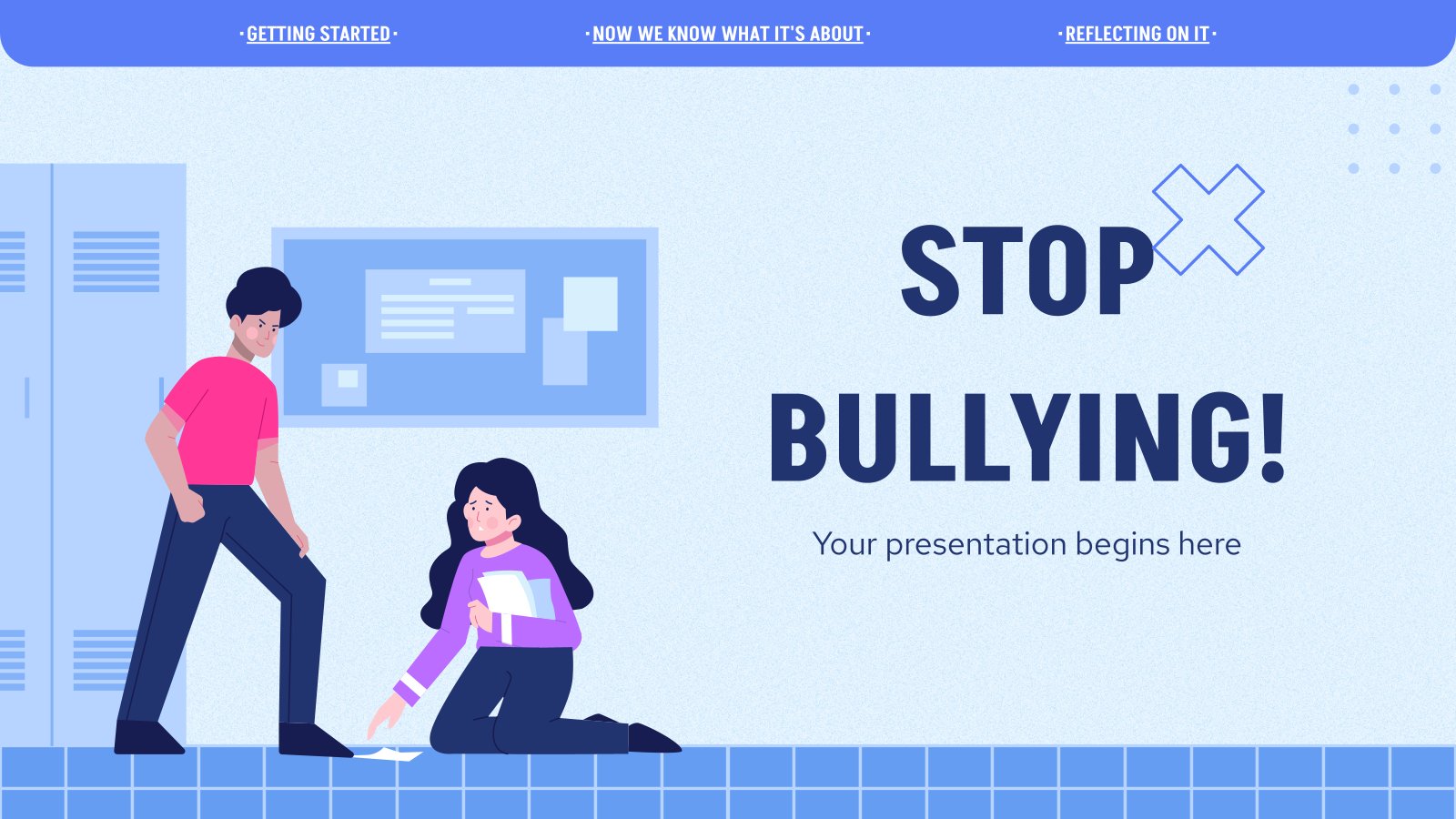
stop bullying
11 templates
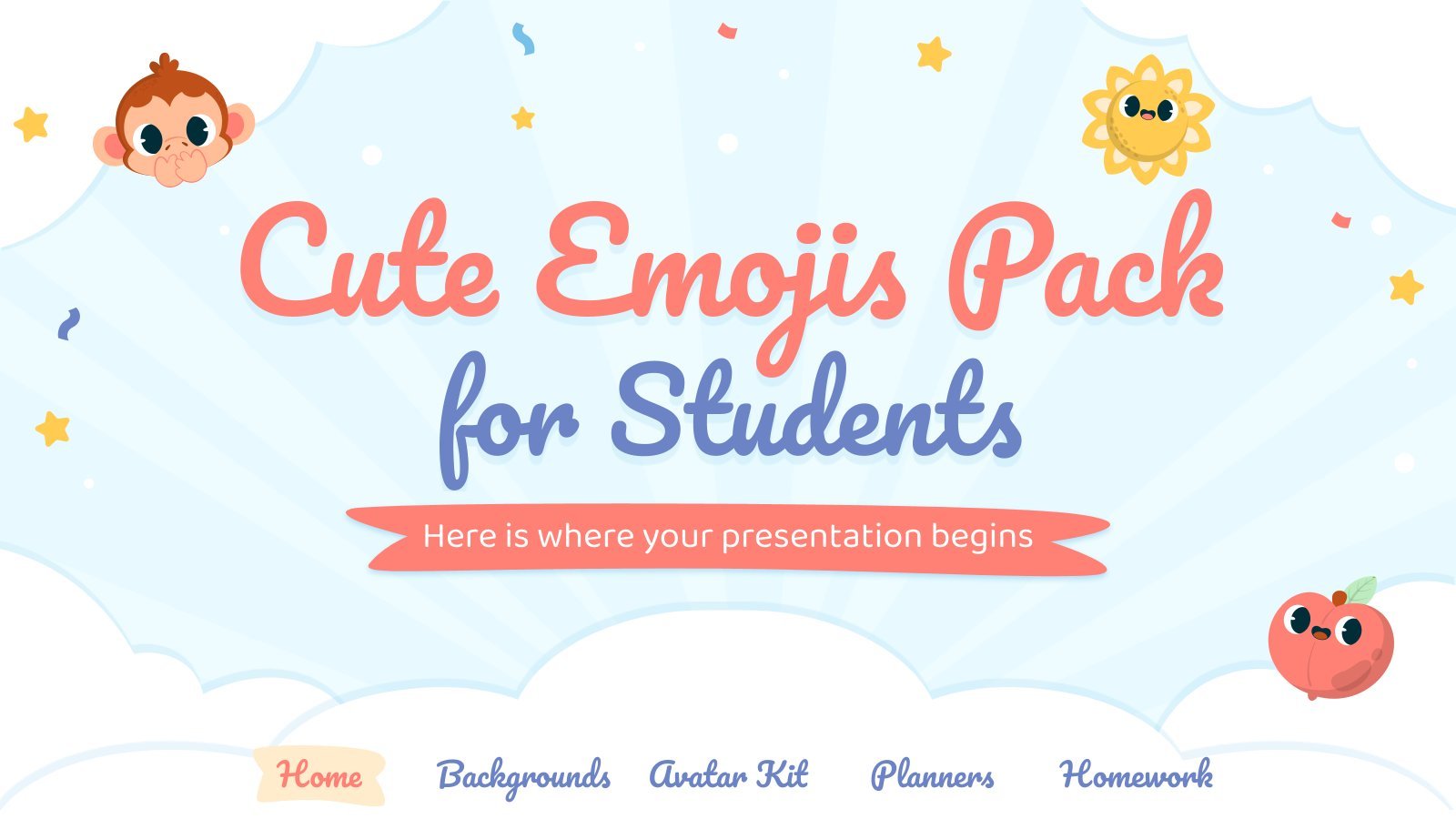
sunday school
65 templates

first day of school
69 templates

team introduction
23 templates

94 templates
Introducing Myself
It seems that you like this template, introducing myself presentation, free google slides theme, powerpoint template, and canva presentation template.
You never know when a slideshow about yourself could come in handy. Be prepared and use this template to introduce yourself to the audience. Explain your work, your strengths, your personal goals, your values, whatever you can come up with! The slides are cool and contain lots of compositions where you can be creative. Green, the color of self-growth, is the main hue here!
Features of this template
- 100% editable and easy to modify
- 35 different slides to impress your audience
- Contains easy-to-edit graphics such as graphs, maps, tables, timelines and mockups
- Includes 500+ icons and Flaticon’s extension for customizing your slides
- Designed to be used in Google Slides, Canva, and Microsoft PowerPoint
- 16:9 widescreen format suitable for all types of screens
- Includes information about fonts, colors, and credits of the free resources used
How can I use the template?
Am I free to use the templates?
How to attribute?
Combines with:
This template can be combined with this other one to create the perfect presentation:

Attribution required If you are a free user, you must attribute Slidesgo by keeping the slide where the credits appear. How to attribute?

Register for free and start downloading now
Related posts on our blog.

How to Add, Duplicate, Move, Delete or Hide Slides in Google Slides

How to Change Layouts in PowerPoint

How to Change the Slide Size in Google Slides
Related presentations.

Premium template
Unlock this template and gain unlimited access
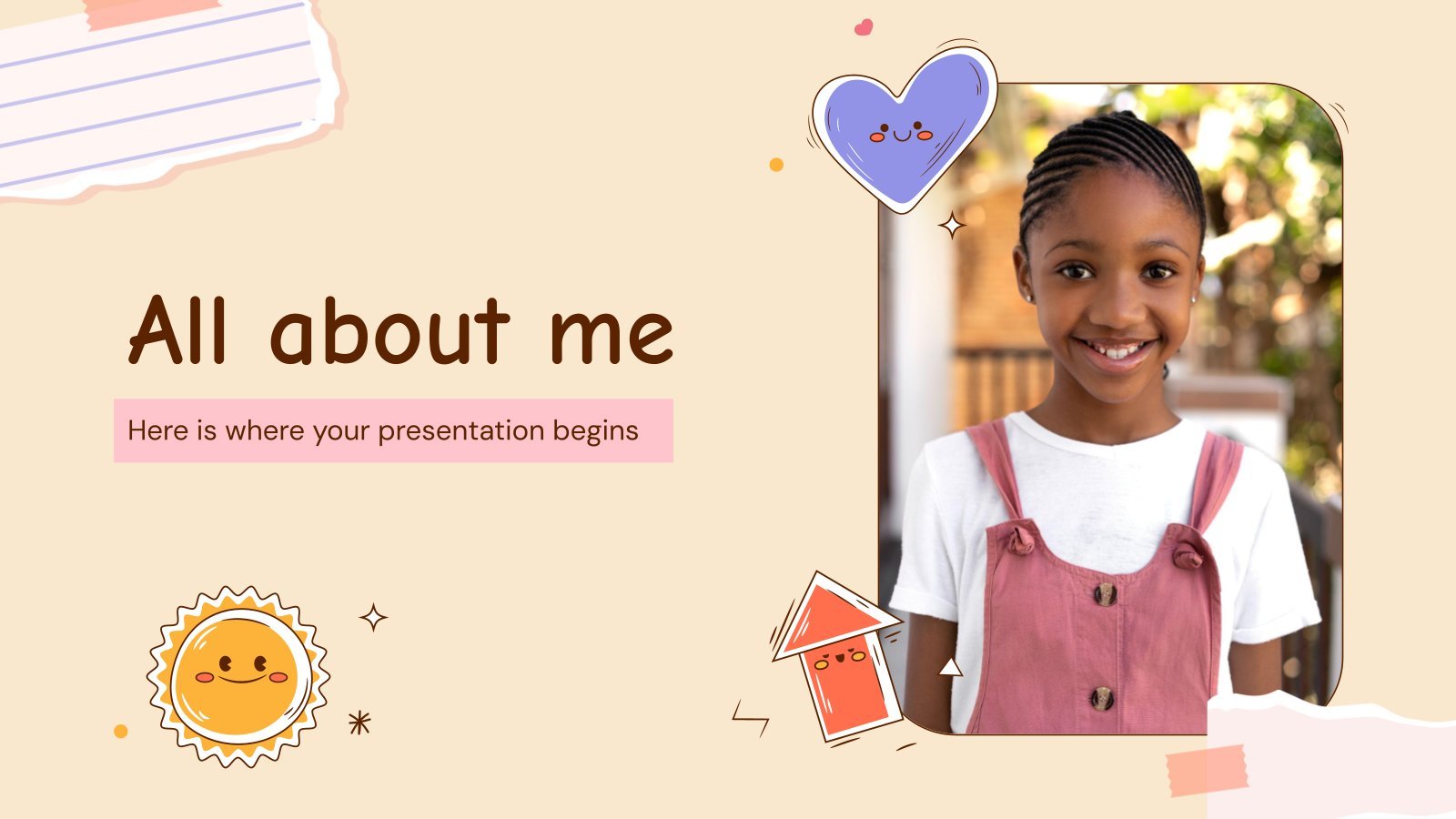
Register for free and start editing online
- See All Courses >
- SUCCESS STORIES
- GET YOUR FREE LINKEDIN HEADLINE SCORE >>
- GET YOUR FREE RESUME SCORE >>
- GENERATE YOUR JOB-WINNING COVER LETTER >>
- FIND ANY CONTACT’S EMAIL ADDRESS >>
- ResyMatch.io Scan and score your resume vs. any target job.
- ResyBuild.io Build a job-winning resume using proven templates and advice.
- CoverBuild.io Have AI generate a personalized, job-winning cover letter in
- HeadlineAnalyzer.io Transform your LinkedIn headline into a job-generating machine.
- ResyBullet.io Scan, score, and upgrade your resume bullets.
- Mailscoop.io Find anyone’s professional email address in seconds.
- The Job Search Email Playbook Our 100+ page guide to writing job-winning emails.
- Value Validation Project Starter Kit Everything you need to create a job-winning VVP.
- No Experience, No Problem Learn how to change careers with no experience.
- The Interview Preparation System A proven system for job-winning interview prep.
- The LinkedIn Launch Formula A proven system for six-figure success on LinkedIn.
- See All Blog Posts Check out all of our job search articles & posts.
- HeadlineAnalyzer.io Scan your LinkedIn Headline and turn it into a job-generating machine.
- LinkedIn Profile Optimization Our comprehensive guide to optimizing your LinkedIn profile.
- LinkedIn Headlines Learn how to write a crazy-effective LinkedIn headline.
- LinkedIn Profile Picture Learn how to create a job-winning LinkedIn profile picture.
- LinkedIn About Section Write a job-winning About section (with examples!)
- LinkedIn Cover Photos Learn how to create a job-winning LinkedIn cover photo.
- GET YOUR FREE LINKEDIN HEADLINE SCORE >>
- ResyMatch.io Scan your resume and turn it into a job-generating machine.
- ResyBuild.io Build a beautiful, job-winning resume using recruiter-approved templates.
- Resume Examples Check out example resumes for a range of job titles and industries.
- How To Write A Resume Learn how to write a resume that actually wins job offers.
- Resume Summaries Our guide on writing a job-winning resume summary.
- Resume Tips & Action Words 175+ tips & examples to supercharge your resume.
- GET YOUR FREE RESUME SCORE >>
- CoverBuild.io Use our tool to generate a personalized, job-winning cover letter in
- Cover Letter Examples Check out example cover letters for a range of job titles and industries.
- How To Write A Cover Letter Learn how to write a cover letter that actually wins job offers.
- Cover Letter Templates Check out our proven, job-winning cover letter templates.
- Addressing A Cover Letter Learn how to start a cover letter the right way.
- GENERATE YOUR JOB-WINNING COVER LETTER >>
- Mailscoop.io A tool to help you find anyone’s professional email in seconds.
- How To Get A Job Without Applying Online Our flagship guide for effective job searching in today’s market.
- How To Network Our comprehensive guide on learning how to network.
- Tips For Better Networking Emails 6 tips for writing networking emails that actually get results.
- What To Ask In An Informational Interview 10 great questions to ask during a networking conversation.
- FIND ANY CONTACT’S EMAIL ADDRESS >>
- How To Prepare For Interviews Our proven preparation framework for turning more interviews into offers.
- How To Create A Job-Winning Interview Presentation Learn our “silver bullet” Value Validation Project presentation strategy.
- Interview Questions & Answer Examples Job-winning example answers for common interview questions.
- What To Wear To An Interview A simple guide to dressing for the job you want.
- How To Write A Job-Winning Thank You Note Learn how to write a post-interview thank you that wins job offers.
50 Words To Describe Yourself In An Interview [+Examples!]

- LinkedIn 52
- Pinterest 0
If you're like most people, you probably find it difficult to describe yourself in just a few words. After all, there are so many qualities that make up a person!
Luckily, there are some tried and true ways to make sure you put your best foot forward when it comes time to describe yourself.
In this blog post, I'll share 50 words to describe yourself in an interview and 8 example answers that you can use as inspiration to help get your message across clearly.
I recommend reading this piece from top to bottom. However, if you're interested in specific topics, just jump to the following sections:
Finding Words To Describe Yourself: Start By Thinking About The Qualities That Make You Unique
- Best Words To Describe Yourself On A Resume
Best Words To Describe Yourself In An Interview (With Examples!)
By following the tips in this post, you'll be able to present yourself in the best possible light and make a great impression on potential employers.
Let's get started!
What makes you unique? Are you creative? Passionate? Driven? These are just a few of the many qualities that make people who they are. When you know what makes you special, you can start to focus on how you can use those qualities to achieve your goals.
Let's say you have an interest in arts, for instance, and have pursued a career in graphic design. You might be described as someone creative.
Or, maybe, you're the type of person who fights for a cause you think is worth fighting for. One might describe you as passionate.
If you have a background in entrepreneurship, on the other hand, you might be described as driven.
No matter what qualities make you unique, remember that they can be used to help you achieve success.
How To Describe Yourself In 55 Words Or Less
Describing yourself in less than 55 words can feel like a challenge. The trick here is to grab a unique trait that best describes you and bring in some examples that validate this trait. For instance, let's say you want to describe yourself as productive . Here's what an answer could look like:
My best trait is productivity. For example, in my previous role as a Marketing Manager at BlueCode, our department was often bottlenecked due to new campaign requests coming from Product and Sales. I used a free project management tool to streamline workflows and managed to boost deliverables by 20% in the first quarter of 2023.
See? The 55 words above effectively describe the candidate as productive using a specific example!
Best Words To Describe Yourself on a Resume
Describing yourself in your resume and describing yourself during an interview are two very different things.
During an interview, you will want to focus on more aspects of your personality; however, for your resume, you'll need to use words that are mostly related to your skills, like proactive, committed, and consistent.
And the best way you can do this is by scanning your resume and matching it with the job description you are applying for. This way, you can fill in the gaps with words that describe yourself and have a good fit with the job!
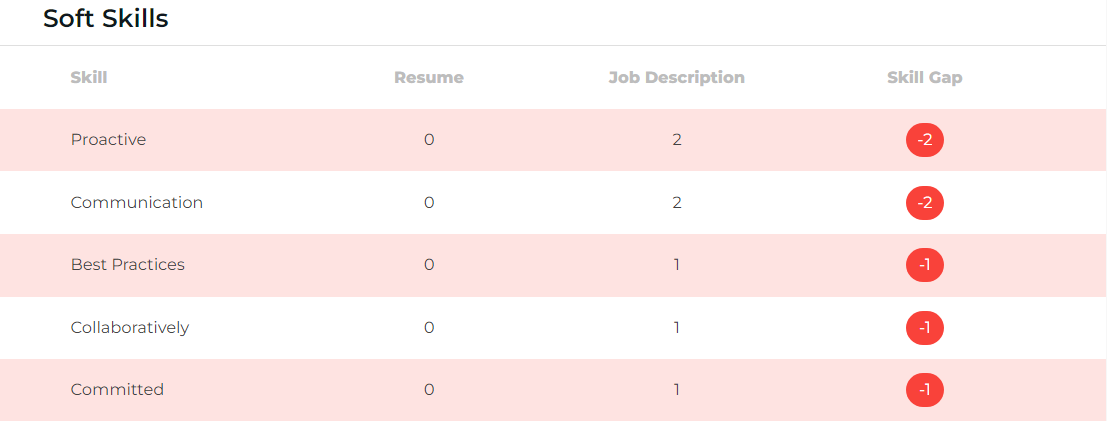
To do this, run over to ResyMatch.io or simply upload your resume and copy and paste the job description below to match the results:

Copy/paste or upload your resume here:
Click here to paste text
Upload a PDF, Word Doc, or TXT File
Paste the job post's details here:
Scan to compare and score your resume vs the job's description.
Scanning...
During an interview, it's also important to think about what in-demand soft skills you have, and how you will convey those traits to a recruiter or hiring manager.
For instance:
Example #1: Describing yourself as Creative : I am creative and passionate about my work. I am always looking for new ways to express myself and I strive to create the best work possible through graphic design. I believe that art should be accessible to everyone, and I strive to make my work available online to as many people as possible on platforms like Behance and Dribbble, as well as open-source communities. I am always learning and growing as an artist – I’ve recently completed my Graphic Design Certification with Adobe, and I hope to continue to develop my skills for years to come.
Notice how, in the example above, this candidate didn’t limit their answer to: “I am creative”, period. Instead, they used this opportunity to also share what drives them and what skills they use to exercise their creativity. Then, they wrap up by stating their desire to continuously improve!
If you’re still struggling to find the best words to describe you, don’t worry. We’ve crafted a few tips to help inspire you.
And our first tip is…
#1 Use Adjective Words To Describe Yourself
When you're describing yourself, it's important to use positive words such as “hard-working,” “driven,” and “creative”. After all, you want to make a good impression.
These words will show potential employers that you are a go-getter who is willing to put in the work to achieve success. Associating yourself with positive words is a powerful way to communicate your soft skills to a potential employer.
Here's a list of 30+ words to describe yourself through adjectives:
- Self-Starter
- Hard-working
- Collaborative
- Team-Player
- Considerate
- Resourceful
- Disciplined
- Trustworthy
When you start to use these words to describe yourself, be sure to use your experiences to back up your adjectives. Words alone will not be enough to convey your value and experience to a hiring manager.
Example #2: Describing yourself as Trustworthy :
My team could always count on me to get the job done. I try my best to never miss a deadline and always stay on time by communicating honestly and transparently with both my teammates and the department manager. I remember there was this one time in my previous role when we were working on a report to present to our CEOs and I collected the data from a different period, which not only led to misleading results but also delayed the workflow and conclusion of the report. Once I realized this, I immediately spoke to my colleagues and owned up to my mistakes, then negotiated with my manager a deadline extension so I could re-run the data. Since then, I’ve added a revision step in my work process so I can flag any issues before moving forward, and I’m now the go-to person on my team for quality control.
Notice how this candidate uses past experiences to best illustrate their personality trait. They also let the hiring manager know what they've learned from this experience. That's way better than simply answering “I am a trustworthy person”!
To craft answers like the one above, you can brush up on your Star Interview Method skills to better incorporate these describing words into your career stories. Be as clear as possible with your language, and make sure your stories illustrate the qualities you want to highlight.

#2 Share A Personal Story To Illustrate One Of Your Qualities
Be specific when you're describing your accomplishments and qualities. For example, if you say that you are “hard-working,” share a story about a time when you went above and beyond the call of duty to get a project done.
This will help potential employers see that you are not just saying that you are hard-working, but that you have actual proof to back up your claim.
Example #3: Sharing a personal story, describing yourself as Resourceful : As a Customer Success Manager at TechVista, I was tasked with creating a presentation to show the board of directors how we might improve client education during onboarding to help improve downstream feature adoption. At the time, I didn't have much experience in onboarding, so I was a bit overwhelmed with where to start. But I wasn't going to give up. First, I set up meetings with everyone in our Implementation team to understand how we are currently educating customers, as well as the tools and resources available to us. Next, I performed competitive analyses on the onboarding process for three of our competitors. I combed through YouTube tutorials, customer reviews, and even booked demos with the competitor's sales teams to ask more about what onboarding would look like. In the end, the board actually recommended adopting my strategies. We rolled it out across our Implementation and CS teams and saw an 17% increase in client retention over the next 12 months. My manager promoted me to Senior Customer Success Manager that year as a result!
Example #4: Describing your work experience using the word Innovative : At my previous job, I was tasked with coming up with a new marketing campaign that would help increase sales. I brainstormed for days, but I just couldn't come up with anything that felt fresh and new. I decided to partner with a stop-motion video maker who was able to showcase our products innovatively. I crafted the script for the video and sat side-by-side with them for a week so we could design the storyboard. Then, I set up a meeting with the Marketing team to set up a distribution strategy centered around digital channels like social media, online communities, and paid media. I presented the strategy to our Marketing Manager and it was approved with minor changes. The campaign was launched in the following quarter and lasted eight weeks. By the end of that period, we increased Sales-Qualified Leads by 38%, which helped generate six-figure revenue!
Both of these examples show how you can describe specific experiences in your career. Whether you came up with a new marketing campaign or found a new way to do something, sharing your success stories in an interview will help a recruiter or hiring manager see your value and what you could bring to their company.
No matter what your unique qualities are, remember that you can use them to your advantage. Be specific when you're describing your accomplishments and qualities, and use your experiences to back up your claims. With a little effort, you can use your unique qualities to stand out from the crowd and land the job you've always wanted.
#4 Talk About Your Professional Experience And Accomplishments
When you're asked to describe yourself, it's important to include both your professional and personal experiences. After all, your potential employer will want to know not only what qualities you have, but also how you've used those qualities to achieve success in your career. It's likely that you will be asked, What is your greatest accomplishment ?” in an interview, so you'll want to be prepared ahead of time!
Four things you might want to include are:
- Your professional experience – What results did you drive in your previous role?
- Your accomplishments – How did you help your team/customers/company succeed?
- Any awards or recognition you've received – Were you recognized for anything specific?
- What you've learned in your career so far – How did you grow professionally in your career?
Here's 10+ action words to describe your accomplishments and experience:
Example #5: Using the action word Developed to describe an accomplishment: As a Sales Manager at my previous job, I was always challenged to find new ways to increase sales. One of our sales pitches at my previous company focused on how our solution could help businesses reduce marketing costs by 20% in the first month, but it was difficult for leads to visualize this in a single meeting. I collaborated cross-functionally with the Software Engineering and Marketing teams to develop and market a free online calculator that showed how our tools helped companies leverage more cost-efficient paid media campaigns, dropping their CPC while simultaneously increasing impressions. The feature was launched ten weeks later and, by the end of that quarter, the company was able to increase sales by 32% using this resource.
Example #6: Describing your professional experience using the word Organized : I am an organized and detail-oriented person, which has helped me excel in my career as an events planner. No matter how big or small the event is, I always use the same system to keep track of all the details. Last year, for instance, I was responsible for planning a corporate event with 500+ attendees. The client was holding a cocktail party and hosting ten different panel discussions. So, along with setting the decorations, catering, audio-visual, and managing the staff at the event, I also had to organize the speakers’ agendas so everything would run smoothly. I started planning months ahead of the event and set up a collaborative board in Trello, a project management tool, where I could set up deadlines and keep track of the status of each task. By adopting this system, I was able to have everything set two weeks prior to the event!
Both of these examples show how you can use your professional experiences to demonstrate your qualities. When describing your accomplishments, be sure to include specific details and use action words.
If you're struggling to think of specific examples, take a look at your resume. Chances are, you've already listed some of your professional accomplishments there. You can also think about a time when you went above and beyond at work or helped solve a problem.
Once you have a few examples in mind, take some time to brainstorm how you would describe each experience. Remember to use action words and be as specific as possible. By doing this, you'll be able to paint a picture of yourself as a competent and successful professional.
#4 Words To Describe Yourself That Focus On The Future
It's important to focus on the future as this shows potential employers that you are always looking for ways to improve and grow.
When you're interviewing for a job, let the hiring manager know what your career goals are and where you see yourself in the future. It shows them that you care about your career and are looking for a long-term opportunity. It also gives them a better idea of where you see yourself fitting in at their company.
- Your short- or long-term goals – What career goals do you have now and in the future?
- What you are hoping to achieve in your career – What is your career path ?
- What skills you want to learn – Be specific!
- How you plan on developing your abilities – Courses, side projects, on the job training, etc.
Here are a few words to describe your future plans:
Example #7: Your plans to Advance in your career path: I am always looking for ways to advance in my career. In the next three years, I see myself as a Director of Sales, and, to achieve this goal, I am currently working towards getting my MBA. I’m also taking courses on leadership and management to expand my skill set. However, I understand that this role also requires experience, so I’ve been spearheading new projects in my current position at ByteBurst to gain more experience in leading and motivating a Sales team. For instance, I recently built a squad within the Sales team dedicated to an upselling strategy that aims to upgrade our SaaS customers from the Basic plan to the Premium plan. To exercise my leadership skills, I’ve set up bi-weekly meetings so the squad can share their insights with the ongoing strategy and so I can support them in any way I can to achieve our goals as a team.
Example #8: Your plans to Develop your abilities: I am always looking for ways to improve my skills. In my previous job, the company was migrating its servers to AWS, and I began to develop an interest in cloud computing. After several courses, I was able to take an AWS Certification, and I am now preparing to take my certification as a Professional Cloud Architect with Google Cloud.
In conclusion, when you are asked to describe yourself, it's important to use positive words, share a personal story, focus on your professional experience and accomplishments, and focus on the future. Doing so will give potential employers a well-rounded picture of who you are and what you can bring to the table.
Looking for more interview tips? These posts will help you prepare for your next interview:
- Interview Preparation: The Key To A Successful Job Interview
- “Tell Me About Yourself!” How To Impress Your Interviewer
- How To Ace Your Answer To “What Is Your Greatest Weakness?”
LEAVE A REPLY Cancel reply
You must be logged in to post a comment.
Most Popular Posts

YOU’VE SEEN AUSTIN IN

WHAT CAN I HELP WITH?

Welcome Back To Cultivated Culture!
Log into your Cultivated Culture account using one of the options below:
You have exceeded the maximum number of phone messages in a 24 hour period. We limit the number of times you can request security codes in order to protect your security. Please try again later or /contact">contact us for assistance with accessing your account.
Forgot your password? Click here to reset.
Need a free acount? Click Here To Sign Up
By logging in, you agree to Cultivated Culture's Terms of Use , Privacy Policy , and agree to receive email updates.
One Free Account, Four Job-Winning Tools
Sign up for a free Cultivated Culture account and get access to all of our job search tools:
Your Bullet Score is:
Sign up for a free Cultivated Culture account to get the full breakdown of your bullet along with suggestions for improving it:
Sign Up To Save & Export Your Resume
Sign up to create, save, and export your resume and get access to our suite of job search tools!
Sign Up To Get More Free Email Searches
Create a free account to unlock more email searches and get access to all four of our job-winning tools:
Your Headline Score is:
Sign up for a free Cultivated Culture account to get the full breakdown of your headline along with suggestions for improving it:
Already have an acount? Click Here To Log In
We Just Need You To Verify Your Email.
We just emailed you a 6-digit code. Please check your email and enter it below.
Note: Your progress will not be saved until your email is verified. Closing this pop up or window might cause you to lose your progress.
Invalid Code
Choose one of the options below to get the verification code we sent you!
We'll need you to verify your email address before you're able to unlock free scans.
We'll need you to verify your email address before you're able to unlock free templates, saves, and exports.
We'll need you to verify your email address before you're able to unlock free email searches.
We sent a verification code to your email, all you have to do is paste that code here and submit to get full access!
Looks Like You Still Need To Verify Your Email Address!
Whoops! Looks like you still haven't verified your email address. We'll need you to do that before granting free, unlimited access to our tools.
If you can't find the original verification email, click the link below and we'll send a new one:
Sent! Please check your email.
Oops you've hit your credit limit..
Looks like you've used all 10 of your free credits for the month. Your credit limit will refresh in days. You can learn more about your credit limit here.
Want to stop worrying about credits?
Sign up for our Unlimited plan to get instance unlimited access to all of our jon search tools for one low price. Click below to learn more:
Go Unlimited!
Change plan.
Upgrade your plan to get unlimited access to all 5 of our offer-winning job search tools and 200 email searches / week:
Go Unlimited (& Save 10%)!
Upgrade to get unlimited access to our resume tools, 200 email searches / week, and 10% off our regular pricing thanks to your friend :
Your Unlimited plan comes with...
Unlimited access to all 5 of our resume tools
200 Mailscoop searches per week
No obligations - cancel any time
By clicking "Upgrade My Plan," you agree to Cultivated Culture's Terms of Service and Privacy Policy
By clicking "Change Plan," you agree to Cultivated Culture's Terms of Service and Privacy Policy
Confirm Your Plan Change
Here is a summary of your plan change:
Current Plan:
Please note the following for plan changes:
Your new plan and rebill date will be effective immediately
The number above depict retail plan pricing, any adjustments or credits will be available in the Invoices section of your Billing tab
If you're moving to a lower cost plan, the difference will be credited to your account and applied towards your next payment
By clicking "Confirm Plan Change," you agree to Cultivated Culture's Terms of Service and Privacy Policy
Unlimited Plan Upgrade
Change payment method.
Promo code has been applied to your purchase!
Note: This is a monthly subscription, your card will be automatically charged every month until you cancel your plan.
Terms of Use | Privacy Policy
(C) 2024 Cultivated Culture
Note: You will not be charged for updating your credit card using this form. After your new card is added, you will be billed on the date of your next billing cycle.
Upgrade Complete!
You are officially a
Unlimited Member
Invoice Details
Paid Today:
Start Date:
Subscription:
Next Bill Date (Est.):
Note: This receipt and future invoices will be available in the Billing Tab of your Account Dashboard .
Do You Want To Secure Your Account?
Increase your account security with one of our multi-factor authentication options:
Choose An Authentication Method
Awesome! Let's make your account more secure.
Choose your preferred authentication method:
Text Message Authentication
Enter the phone number that you want to use to set up text-based authentication for your account:
Text Message Verification Code Sent!
Please check your phone for verification code and enter below:
Email Verification Code Sent!
Please check your email for verification code and enter below:
No problem, we'll skip this for now. Do you want us to remind you to secure your account?
It's great to have you. We just have a few questions so we can personalize your experience with our tools:
- I haven't applied to any jobs yet and I am not sure where to start
- I know what types of jobs I am looking for and I have started applying or I plan to start soon
- I have been applying to jobs for 3 months or longer, but haven't gotten the results I'd hoped for
- Get a job in the same industry I currently work in
- Switch careers and get a job in a new industry
- Get promoted at my current company
- Improve my resume
- Improve my cover letter
- Enhance my LinkedIn presence
- Find jobs that I am compatible with

- SUGGESTED TOPICS
- The Magazine
- Newsletters
- Managing Yourself
- Managing Teams
- Work-life Balance
- The Big Idea
- Data & Visuals
- Reading Lists
- Case Selections
- HBR Learning
- Topic Feeds
- Account Settings
- Email Preferences
How to Make a “Good” Presentation “Great”
- Guy Kawasaki

Remember: Less is more.
A strong presentation is so much more than information pasted onto a series of slides with fancy backgrounds. Whether you’re pitching an idea, reporting market research, or sharing something else, a great presentation can give you a competitive advantage, and be a powerful tool when aiming to persuade, educate, or inspire others. Here are some unique elements that make a presentation stand out.
- Fonts: Sans Serif fonts such as Helvetica or Arial are preferred for their clean lines, which make them easy to digest at various sizes and distances. Limit the number of font styles to two: one for headings and another for body text, to avoid visual confusion or distractions.
- Colors: Colors can evoke emotions and highlight critical points, but their overuse can lead to a cluttered and confusing presentation. A limited palette of two to three main colors, complemented by a simple background, can help you draw attention to key elements without overwhelming the audience.
- Pictures: Pictures can communicate complex ideas quickly and memorably but choosing the right images is key. Images or pictures should be big (perhaps 20-25% of the page), bold, and have a clear purpose that complements the slide’s text.
- Layout: Don’t overcrowd your slides with too much information. When in doubt, adhere to the principle of simplicity, and aim for a clean and uncluttered layout with plenty of white space around text and images. Think phrases and bullets, not sentences.
As an intern or early career professional, chances are that you’ll be tasked with making or giving a presentation in the near future. Whether you’re pitching an idea, reporting market research, or sharing something else, a great presentation can give you a competitive advantage, and be a powerful tool when aiming to persuade, educate, or inspire others.
- Guy Kawasaki is the chief evangelist at Canva and was the former chief evangelist at Apple. Guy is the author of 16 books including Think Remarkable : 9 Paths to Transform Your Life and Make a Difference.
Partner Center

How to Prepare in Advance
42 top adjectives to describe yourself: a list, what if i am asked to describe myself in three words, why is this question so tricky, frequently asked questions, how to answer the interview question "how would you describe yourself" (with examples).
Updated March 6, 2023

All products and services featured are independently selected by WikiJob. When you register or purchase through links on this page, we may earn a commission.
“How would you describe yourself?” generally features in strengths-based job interviews and is an extremely common interview question.
The question is designed to show the interviewer how you perceive yourself and reveal the key attributes that you think make you a good match for the role.
It is similar to:
- “Tell me about yourself”
- “ How would others describe you? ”
- “What are you like to work with?”
- “List three adjectives that best describe you”
- “What is your greatest weakness?”
- “Why should we hire you?”
Describing yourself succinctly to potential employers is also known as an elevator pitch , and it is well worth practicing this skill even if you haven’t got an interview to go to. It is a great tool for networking.
One of the most important things to keep in mind when preparing your answer is that this question is not about your character in general, it’s about your understanding of yourself in relation to the job you’re interviewing for .
It’s therefore important that you do your research as part of your job search and have a solid knowledge of the company and the role before preparing your answer, to ensure you can tailor it effectively.
Make sure you carefully read the job posting and job description as they will often list the desirable attributes of the candidate, or give important clues.
One of the best ways to start preparing is to make a list of positive adjectives that best describe you and that you feel make you a good fit for the role, based on the job description and your knowledge of the position and the company.
For example, if the position is a sales role and you enjoy negotiating and meeting new people you should include that in your answer, as negotiation and communication skills are key requirements.
These are the top adjectives that hiring managers or recruiters want to hear when they ask you to describe yourself.
When thinking about which ones best apply to you, make sure you think about what you have excelled at in your previous jobs and what you need to (and can) demonstrate in your new role.
Ensure you check the job description to make sure the adjectives you focus on match the job you are applying for:
- Accountable
- Collaborative
- Conscientious
- Detail-oriented
- Disciplined
- Experienced
- Hardworking
- People-person
- Responsible
- Results-oriented
- Self-starter
- Subject-matterexpert
Once you’ve completed your list, it’s a good idea to pick three adjectives that you feel are the best match for the role and focus your answer around them.
Generally, an interviewer will not want you to respond with just a list of words, nor will they want your life story, consisting of long-winded examples of your past experiences.
Instead, they’ll want you to expand on the adjectives and explain what these attributes and characteristics mean about you, which will in turn show why you’re the best fit for the position.
If an interviewer does want you to limit your answer to just three words, this still provides valuable insights into your priorities, how well you understand the position and how you react when put on the spot.
There are several key reasons why interviewers may ask you to describe yourself in three words. The first is to gain an understanding of what values and qualities you consider most important for the position you're applying to and as an employee in general.
The words you choose will help an interviewer determine whether you would fit well into the company culture and whether you have a firm grasp of what the role and company requires in an employee.
They will also give an interviewer an understanding of what you consider to be your best qualities or characteristics.
It's important to be honest with the words you choose, as it will not benefit yourself or the employer if you do not have the qualities you claim to have.
The words you choose to describe yourself should demonstrate to interviewers that you are a well-rounded and professional individual who will be a valuable addition to the company. They should provide a sense of your personality, preferred working style and your key values, while remaining relevant to the position.
“How would you describe yourself?” is a tricky question for two main reasons. Firstly, it requires you to strike the right balance of pride and belief in your strengths with modesty.
As you generally won’t be required to back up your answer with examples from previous roles, it can also be difficult to create an effective answer that doesn’t feel vague.

This question is not about your general character; it’s about your role suitability.
To find out which jobs fit your personality best, visit our partner CareerFitter and take the Career Test for FREE .
Pass the Quiz for FREE
Effective Sample Answers
The following all make for good example answers, based on the type of personality that best applies to you.
Ensure you always tailor your answer to the job and employer you are applying for.
1. The Creative Thinker
I’m a creative thinker. I think it’s important to approach tasks and issues from different angles, rather than just doing what has always been done. By having an open mind and taking a different approach, I believe you can find new and improved ways of doing things. As a manager, I like to foster this approach in my team too. It means they feel comfortable suggesting and discussing new ideas, often generating unusual and effective solutions as a result, which is great for team morale and for the business.
Why is this a good answer?
Employers like it when their employees are able to think outside of the box. This means that they are able to consider a problem from a variety of angles in order to find a solution which works.
Having the ability to think creatively can help to bring new ideas and solutions to a workplace. It is especially useful for those looking for managerial roles as creative thinkers will often inspire those they work with to also think creatively.
2. The Strategist
I’m detail-orientated and results-driven. I like to look at all the variables of a project in order to set realistic goals and determine the actions required to achieve them. I get real satisfaction from ensuring a plan runs smoothly in order to achieve the optimum projected results to deadline.
No matter what company you work for, there will always be goals and targets which need to be reached. Employers want to know that their employees are determined to reach their targets and are motivated to do their best.
Ensure you can back your claims up with quantifiable results, just incase of follow up questions.
3. The Constant Learner
I love learning new things and am always on the lookout for new opportunities to develop and grow within my role, whether that’s learning new skills, taking on a new project or collaborating with other departments. I’m a positive person who likes to excel at what I do, and I think the best way to do that is to constantly challenge myself to learn as much as I can and to perform to the best of my abilities every day.
For an employer, an employee who wants to learn is one who is likely to consistently try to better themselves. They will be looking for new ways to do their job more effectively, aspire towards promotions and are motivated towards continual improvement.
4. The Problem Solver
I’m a good communicator with strong analytical skills. I think I’m at my best when working with a team to solve complex issues, troubleshooting and analysing a problem from different angles to find a solution that benefits everyone. I love a challenge and find working together to solve critical business issues really rewarding.
No matter what industry you work in, or what your role is, there will be occasions when issues occur which need to be solved. Potential employers will want to know that the individuals they hire are going to have the ability to analyse an issue in order to find a solution.
5. The People Person
I would describe myself as a real people person. I’m at my happiest meeting new people and using my communication skills to form and maintain effective working relationships. In particular, it gives me a real sense of pride to be able to repair and improve relationships between different departments through listening, discussion and clear communication.
Good working relationships are a vital part of ensuring a positive and encouraging working environment. The relationships that others have within the workplace can affect staff morale, productivity and many other areas of a company. For this reason, employers will look to hire individuals who are able to work well alongside each other and desire to create a harmonious working environment.
6. The Passionate Worker
I would say that I am passionate. I truly love what I do and I feel that this makes me a better worker as a result. I am dedicated to providing my very best work every time. I believe that my passion for this industry is what leads me to keep striving to achieve more.
People who are passionate are more likely to also be reliable when it comes to their performance and the standard of their work. Employers are passionate about the company that they run and they always appreciate it if their employees love their company just as much as they do.
7. The Organised Worker
I pride myself on my strong organisational skills. I try to be organised in every area of my life, both at work and at home. I find that this helps me to stay ahead of deadlines as well as ensuring that I am aware of any changes which may affect the requirements of my work. Other people have told me that because I am organised, it helps them to stay organised too.
Organisational skills are useful in every area of working life as they can be applied to different circumstances. For this reason, employers like to hire workers who have good organisational skills. They are likely to be more reliable and their positive attitude can help to motivate their co-workers.
8. The Natural Leader
I would consider myself to be a natural leader. By this, I don’t mean that I like to boss people around, more that I am able to identify where direction is needed and find ways of ensuring that a team is able to work together to achieve a shared goal. Whenever a project leader is required, I will happily put myself forward for the task. I work to identify the strengths of each team member in order to achieve the best possible outcomes.
Employers like to hire staff who are able to work well with others. When you are applying for a role that has the potential to have team leader or managerial responsibilities, it is especially important to show you are a good team player and have the qualities required to lead effectively. When employees have natural leadership skills, this will often mean that they are able to do their job well and have the ability to adapt to situations easily.
9. The Good Communicator
Communication is key to everything in business. This is why I have worked hard to make sure that I am a good communicator. I find that by making sure that I am communicating clearly and effectively, it helps to keep things running smoothly as everyone knows what they need to be doing and when each task needs to be completed. At times, this has also involved helping others to find solutions when they are having issues communicating concerns to one another.
Employers are keen to ensure that the people who work for them are happy in what they do and are working in a harmonious environment. One of the key factors to this is ensuring that communication is clear, effective and consistent. By hiring individuals that have good communication skills, employers are taking steps to maintain open communication throughout the business. This has a positive impact on other areas and is considered to be a desirable trait.
10. The Initiator
I would like to think that I am an initiator. If I see that improvements can be made, then I will try to find a way of achieving this. This can be in relation to any area of my work, whether it is customer satisfaction, working methods, relationships with other staff members or goal accomplishment. If I can find a way to make things better, then I will initiate whatever needs to be done to accomplish this.
Not everybody is suited to be a team leader, just as not everybody is suited to follow others. But when an employer is looking to fill a role that might require a certain level of independence or working with others, they will want to know that they have chosen the right person for the job.
An individual who is able to initiate changes and action when required is well-suited to this type of role. Their ability to think for themselves and work to accomplish goals will mean that employers are able to relax in the knowledge that teams will be working well and efficiently.
What is the best answer for the 'How would you describe yourself' interview question?
Forming an answer to this question depends on what the interviewer is looking at in a potential employee.
Use the keywords in the job description to craft a few sentences that cover the basic skills and competencies that the employer is looking for. You might want to include that you are ambitious and driven for a sales role, or that you love a challenge if you are looking to be employed in an analytical role.
Make sure you are being honest throughout though, as you want to show the recruitment team that you are the right fit for the advertised role.
What are 'How would you describe yourself' interview examples?
In an interview, you might be asked to describe yourself in different ways, so it is a good idea to be ready to answer the question even if it is posed slightly strangely.
You might get it phrased like this:
- "How would your family describe you?"
- "What would a friend tell us about you and your personality?"
- "How would your current or last employer describe you?"
- "What would your worst enemy say about you?"
These are all questions designed to see how well you know yourself and the way you come across to other people.
What is the best way to describe yourself in an interview?
When you are describing yourself in an interview, it is important to be honest.
However, it is always worth using the job description and information from your research so that you know what kind of person they are looking for – you can use this knowledge to highlight your traits, work behaviour and personality that matches what they need in a new employee.
How to answer "What is your best trait?"
Everyone will have a slightly different answer to the question “What is your best trait,” but in most cases, they will either choose to focus on values or beliefs, like honesty or integrity.
When thinking of your best trait, remember what type of person the recruitment team is looking for so you can highlight that as your best trait (if it is true, of course). If in doubt, remember to be positive.
What should I say to describe myself to a potential employer?
When you are thinking of ways to describe yourself to a potential employer, make sure that you know what they want from their employees before you get started.
In your research for the role throughout the recruitment process, you will have gathered lots of information about the daily duties, the values of the organisation, and the traits and work behaviours that they value, so this should be a big part of the way you answer.
Think of a way to describe yourself that is unflinchingly honest, positive, and really demonstrates that you have what it takes to be successful in the role you have applied for.
You might also be interested in these other Wikijob articles:

Or explore the Interview Advice / Interview Questions sections.
Newly Launched - AI Presentation Maker

AI PPT Maker
Powerpoint Templates
Icon Bundle
Kpi Dashboard
Professional
Business Plans
Swot Analysis
Gantt Chart
Business Proposal
Marketing Plan
Project Management
Business Case
Business Model
Cyber Security
Business PPT
Digital Marketing
Digital Transformation
Human Resources
Product Management
Artificial Intelligence
Company Profile
Acknowledgement PPT
PPT Presentation
Reports Brochures
One Page Pitch
Interview PPT
All Categories

Presentation Describing Yourself Powerpoint Presentation Slides
Introduce yourself with confidence using content-ready Presentation Describing Yourself PowerPoint Presentation Slides. Win over an interviewer by showcasing your skills, experience, career graph, and more. Use this professionally designed introduce yourself PPT presentation to keep your audience engaged during the interview. Highlight about your strengths and weaknesses, hobbies, and more with the help of presentation describing yourself PPT templates. Be ready to get all the limelight using about me, career, swot analysis, qualification PPT templates. Flaunt your achievements and accomplishments by not just saying them verbally. Rather, showcase your success and get all the attention you deserve. Download this professionally designed presentation describing yourself presentation deck and prepare yourself for your big interview. Fortify yourself with our presentation about yourself Slides. Acquire the courage to express without fear.

- Add a user to your subscription for free
You must be logged in to download this presentation.
PowerPoint presentation slides
Presenting presentation describing yourself PowerPoint presentation slides. Complete pre-designed deck of 36 content ready PPT templates. This complete deck presentation comprises of stunning background visuals and well researched content. These PPT slides are completely customizable. Change the colour, text and font size as per your requirement. Easy to download. Can be easily converted into PDF or JPG formats. These PPT templates are well compatible with Google slides. Download introducing yourself PowerPoint presentation and get yourself under the spotlight.

People who downloaded this PowerPoint presentation also viewed the following :
- Business Slides , Flat Designs , Concepts and Shapes , Complete Decks , All Decks , Career Planning , General
- Presentation Describing Yourself ,
- Introduce Yourself ,
- Self Presentation
Content of this Powerpoint Presentation
Slide 1 : This slide shows a Presentation Describing Yourself. Add your name and begin. Slide 2 : This is an Agenda slide to showcase these aspects- Achievements & Training, Own SWOT Analysis, Qualifications, Career, About Me, Experience, Hobbies, Skill Set, Language Skills. Slide 3 : This is an About Me slide to provide a brief introduction about yourself with your qualities, specifications etc. Slide 4 : This is also an About Me slide showing- Personal Profile, Achievements, Education, Contact Info, Hobbies, Skills & Languages, Work Experience. Slide 5 : This slide shows a Career Roadmap containing the data of several years. You can add in your achievements etc. in this roadmap. Slide 6 : This slide shows Career prospects in a timeline form which you can add. Slide 7 : This slide shows a Path to Career timeline wherein you can add your career aspects. Slide 8 : This slide presents SWOT Analysis to showcase your threats, weaknesses etc. Slide 9 : This is also a SWOT Analysis (Option 2 of 2) slide to state your- Threats, Strengths, Weaknesses, Opportunities. Slide 10 : This slide decribes your Professional Qualification with their respective icons. Slide 11 : This slide shows the Achievements ( if any) that you have acquired. Slide 12 : This slide showcases Training aspects undertaken. Slide 13 : This slide mentions the Experience - Projects undertaken. Slide 14 : This slide shows the following three aspects included in the Case Study- Challenge, Solution, Results. Slide 15 : This slide shows a range of Skills such as- Creative, Team Player, Assertive, Flexible, Goal Oriented etc. You can decribe your own skills set here. Slide 16 : This slide shows Language Skills. You can add you own language skills here. Slide 17 : This slide describes your Hobbies. Slide 18 : This slide is titled Coffee Break to halt and then proceed further. You may change the slide content as desired. Slide 19 : This slide forwards to Charts & Graphs. Alter/ modify content as per need. Slide 20 : This slide presents a Filled Radar Chart. Compare Product 01, Product 02 and use as per required. Slide 21 : This slide presents Clustered Column - Line graph with which you can compare the products. Slide 22 : This slide shows a Line Chart for two product comparison. Slide 23 : This slide is titled Additional Slides to move forward. You can change the slide content as per need. Slide 24 : This is Our Mission slide. Show your company mission, vision and goals here. Slide 25 : This is an About Us slide with Professional, Creative and Talented as examples. Slide 26 : This is Meet Our Team slide with name and designation to fill. Slide 27 : This is Our Goal slide. State your goals here. Slide 28 : This slide showcases Comparison of two entities - male and female. Slide 29 : This slide shows Financial aspects with these three parameters- Minimum, Medium, Maximum. Slide 30 : This is a Quotes slide to convey company/ organization message, beliefs etc. You may change the slide content as per need. Slide 31 : This is a Dashboard slide to state aspects, kpis, metrics etc. Slide 32 : This is a Timeline slide to present important dates, journey, evolution, milestones etc. Slide 33 : This is Our Target slide to state your targets etc. Slide 34 : This is a Location slide of USA. Mark specific locations for company growth, market etc. here. Slide 35 : This is an Idea Or Bulb slide to state a new idea or highlight specifications/ information etc. Slide 36 : This is a Thank You slide with Address# street number, city, state, Contact Number, Email Address.
Presentation Describing Yourself Powerpoint Presentation Slides with all 36 slides:
Our Presentation Describing Yourself Powerpoint Presentation Slides give a burst of confidence. They get convinced that it is doable.

Ratings and Reviews
by Cletus Ross
July 19, 2021
by Donnie Knight


195 Positive Words to Describe Yourself [with Examples]
By Status.net Editorial Team on August 30, 2023 — 23 minutes to read
Describing yourself positively can make a significant impact on your personal and professional life. It not only improves your self-image but also helps you create a strong, favorable impression on others. As you explore the full list of adjectives in this article, take the time to reflect on your strengths and choose words that best encapsulate your personality. Remember, when describing yourself, being genuine and specific can go a long way in making a lasting, positive impression.
Related: Core Values List: 150+ Awesome Examples of Personal Values
Full List of Positive Words to Describe Yourself
1. Ambitious – “I have big dreams and am always striving to achieve them.” 2. Adventurous – “I love exploring new places and trying new things.” 3. Affable – “I enjoy meeting new people and making friends easily.” 4. Affectionate – “I am very loving and enjoy showing affection to those I care about.” 5. Agile – “I am quick and nimble, able to adapt to changing situations easily.” 6. Alert – “I am always aware of my surroundings and quick to react to any potential danger.” 7. Altruistic – “I am always looking for ways to help others and make a positive impact in the world.” 8. Amiable – “I am friendly and easy to get along with.” 9. Amusing – “I have a good sense of humor and enjoy making others laugh.” 10. Analytical – “I enjoy breaking down complex problems and finding solutions.” 11. Artistic – “I have a creative side and enjoy expressing myself through various forms of art.” 12. Assertive – “I am confident in my opinions and not afraid to speak up for myself.” 13. Attentive – “I pay close attention to details and am always listening to others.” 14. Authentic – “I am true to myself and don’t try to be someone I’m not.” 15. Balanced – “I strive to maintain a healthy balance in all aspects of my life.” 16. Beautiful – “I am confident in my own unique beauty and appreciate the beauty in others.” 17. Benevolent – “I have a kind and generous heart, always looking for ways to help others.” 18. Blissful – “I am content and happy with my life.” 19. Brave – “I am not afraid to face challenges and take risks.” 20. Bright – “I am intelligent and quick-witted.” 21. Brilliant – “I have a sharp mind and excel in many areas.” 22. Calm – “I am able to stay composed and level-headed in stressful situations.” 23. Capable – “I am competent and able to handle a wide range of tasks.” 24. Caring – “I have a nurturing nature and enjoy taking care of others.” 25. Charismatic – “I have a magnetic personality and am able to charm people easily.” 26. Charming – “I have a pleasant and attractive personality that draws people in.” 27. Cheerful – “I have a positive and upbeat attitude that lifts the spirits of those around me.” 28. Clean – “I am neat and tidy, and enjoy maintaining a clean and organized space.” 29. Clear-headed – “I am able to think clearly and make rational decisions even in difficult situations.” 30. Clever – “I have a sharp mind and am able to come up with creative solutions to problems.” 31. Compassionate – “I have a deep empathy for others and am always willing to lend a helping hand.” 32. Confident – “I believe in myself and my abilities, and am not easily shaken by challenges.” 33. Considerate – “I am thoughtful of others’ feelings and needs.” 34. Consistent – “I am reliable and consistent in my actions and behavior.” 35. Courageous – “I have a brave and fearless spirit, willing to take on challenges and face my fears.” 36. Creative – “I have a vivid imagination and enjoy expressing myself through various forms of creativity.” 37. Cultured – “I have a broad knowledge and appreciation of different cultures and ways of life.” 38. Curious – “I have a thirst for knowledge and enjoy learning new things.” 39. Daring – “I am bold and adventurous, unafraid to take risks and try new things.” 40. Decisive – “I am able to make quick and confident decisions even in high-pressure situations.” 41. Dedicated – “I am committed to my goals and work hard to achieve them.” 42. Delightful – “I have a charming and pleasant personality that brings joy to those around me.” 43. Dependable – “I am reliable and can be counted on to follow through on my commitments.” 44. Determined – “I have a strong will and am determined to succeed in all that I do.” 45. Diligent – “I am hardworking and thorough in my approach to tasks and responsibilities.” 46. Disciplined – “I have a strong sense of self-discipline and am able to stay focused and productive even in challenging circumstances.” 47. Dynamic – “I am full of energy and enthusiasm, always ready to take on new challenges and opportunities.” 48. Earnest – “I am sincere and genuine in my actions and intentions.” 49. Easygoing – “I have a relaxed and flexible personality that makes it easy for me to get along with others.” 50. Educated – “I have a strong educational background and am knowledgeable in many areas.” 51. Efficient – “I am able to complete tasks quickly and effectively, making the most of my time and resources.” 52. Elegant – “I have a graceful and refined manner that exudes sophistication and class.” 53. Empathetic – “I have a deep understanding and appreciation for the feelings and experiences of others.” 54. Energetic – “I am full of vitality and vigor, always ready to tackle new challenges and adventures.” 55. Enthusiastic – “I have a contagious enthusiasm and passion for life that inspires those around me.” 56. Ethical – “I have strong moral principles and always strive to do what is right.” 57. Excellent – “I am outstanding in my abilities and excel in many areas.” 58. Experienced – “I have a wealth of knowledge and experience in my field.” 59. Expressive – “I am able to convey my thoughts and emotions effectively through various forms of expression.” 60. Extravagant – “I have a bold and flamboyant personality, unafraid to stand out and make a statement.” 61. Fair – “I am just and impartial, treating everyone with equality and respect.” 62. Faithful – “I am loyal and committed to those I care about.” 63. Fearless – “I have a courageous and bold spirit, unafraid to take risks and face my fears.” 64. Focused – “I am able to concentrate and stay on task, even in distracting or challenging environments.” 65. Forgiving – “I have a compassionate and understanding nature, able to forgive others and move on from past conflicts.” 66. Friendly – “I am warm and welcoming, making it easy for others to feel comfortable around me.” 67. Fun-loving – “I have a lighthearted and playful personality, always looking for ways to have fun and enjoy life.” 68. Funny – “I have a great sense of humor and enjoy making others laugh with my wit and jokes.” 69. Generous – “I am giving and generous with my time, resources, and talents.” 70. Gentle – “I have a kind and gentle nature, treating others with compassion and care.” 71. Genuine – “I am sincere and authentic in my actions and words.” 72. Gifted – “I have a natural talent or ability in a particular area.” 73. Giving – “I enjoy giving to others and find joy in making a positive impact in their lives.” 74. Good-hearted – “I have a kind and caring heart, always looking for ways to help others.” 75. Gracious – “I am courteous and polite, showing gratitude and appreciation to those around me.” 76. Grateful – “I have a thankful and appreciative attitude, recognizing and acknowledging the blessings in my life.” 77. Grounded – “I have a stable and balanced perspective, able to stay grounded in the midst of life’s challenges and opportunities.” 78. Handsome – “I have an attractive and appealing physical appearance.” 79. Happy – “I have a positive and optimistic outlook on life, finding joy and happiness in everyday experiences.” 80. Hardworking – “I am diligent and dedicated, willing to put in the effort and time required to achieve my goals.” 81. Harmonious – “I have a peaceful and cooperative nature, able to work well with others and maintain positive relationships.” 82. Helpful – “I am always willing to lend a hand and offer assistance to those in need.” 83. Honest – “I have a strong sense of integrity and honesty, always telling the truth and being transparent in my actions and words.” 84. Honorable – “I have a strong sense of honor and integrity, always doing what is right and just.” 85. Humble – “I have a modest and unassuming nature, not seeking attention or praise for my accomplishments.” 86. Humorous – “I have a great sense of humor and enjoy making others laugh and smile.” 87. Imaginative – “I have a creative and imaginative mind, able to come up with innovative ideas and solutions.” 88. Impartial – “I am fair and impartial, treating everyone with equality and without bias.” 89. Independent – “I am self-reliant and able to take care of myself without relying on others.” 90. Industrious – “I am hardworking and diligent, always striving to be productive and efficient.” 91. Inquisitive – “I am curious and eager to learn, always asking questions and seeking new knowledge.” 92. Insightful – “I have a deep understanding and perception of people and situations, able to see beyond the surface level.” 93. Inspirational – “I have a motivating and inspiring presence, able to encourage and uplift those around me.” 94. Intelligent – “I have a high level of intelligence and am able to grasp complex concepts and ideas easily.” 95. Intuitive – “I have a strong intuition and am able to sense things beyond what is immediately apparent.” 96. Inventive – “I have a creative and innovative mind, able to come up with new and original ideas and solutions.” 97. Joyful – “I have a joyful and positive outlook on life, finding happiness and contentment in everyday experiences.” 98. Just – “I have a strong sense of justice and fairness, treating everyone with equality and without bias.” 99. Kind – “I have a compassionate and kind-hearted nature, always looking for ways to help and support others.” 100. Knowledgeable – “I am well-informed and knowledgeable in a wide range of areas.” 101. Leader – “I have strong leadership skills and am able to guide and inspire others to achieve their goals.” 102. Lively – “I have a lively and energetic personality, always ready to have fun and enjoy life to the fullest.” 103. Logical – “I have a logical and analytical mind, able to think critically and solve problems effectively.” 104. Loving – “I have a deep capacity for love and care for those around me.” 105. Loyal – “I am faithful and committed to those I care about, always standing by their side.” 106. Meticulous – “I am careful and precise in my work, paying close attention to details and ensuring accuracy.” 107. Modest – “I have a humble and modest nature, not seeking attention or praise for my accomplishments.” 108. Motivated – “I am driven and motivated to succeed in all that I do.” 109. Natural – “I have a natural talent or ability in a particular area.” 110. Neat – “I am organized and tidy, keeping my surroundings clean and orderly.” 111. Noble – “I have a strong sense of honor and nobility, always striving to do what is right and just.” 112. Nurturing – “I have a caring and nurturing personality, always looking out for the well-being of those around me.” 113. Observant – “I am attentive and observant, able to notice details and pick up on subtle cues.” 114. Optimistic – “I have a positive and optimistic outlook on life, always seeing the bright side of things.” 115. Organized – “I am well-organized and efficient, able to keep track of tasks and responsibilities with ease.” 116. Original – “I have a unique and original perspective, able to think outside the box and come up with innovative ideas.” 117. Outgoing – “I have an outgoing and sociable personality, enjoying meeting new people and making connections.” 118. Passionate – “I am passionate and enthusiastic about the things I care about, putting my heart and soul into everything I do.” 119. Patient – “I am patient and understanding, able to remain calm and composed in difficult situations.” 120. Peaceful – “I have a peaceful and serene nature, able to create a calming and harmonious environment.” 121. Perceptive – “I have a keen sense of perception, able to understand and empathize with the feelings and experiences of others.” 122. Persevering – “I am persistent and determined, never giving up on my goals and dreams.” 123. Persistent – “I am tenacious and persistent, able to overcome obstacles and challenges through sheer determination.” 124. Persuasive – “I have strong persuasion skills, able to influence and convince others to see things from my perspective.” 125. Playful – “I have a fun and playful personality, always looking for ways to bring joy and laughter to those around me.” 126. Pleasant – “I have a pleasant and friendly nature, making it easy for others to feel comfortable and at ease around me.” 127. Polite – “I am courteous and polite, showing respect and consideration to others in all situations.” 128. Popular – “I have a likable and charismatic personality, making me well-liked and admired by many.” 129. Positive – “I have a positive and optimistic outlook on life, always focusing on the good and finding solutions to problems.” 130. Powerful – “I have a strong and influential presence, able to make a significant impact in the world around me.” 131. Practical – “I have a practical and pragmatic approach to life, able to make sound decisions based on practical considerations.” 132. Precise – “I am precise and accurate in my work, paying close attention to details and ensuring high quality results.” 133. Productive – “I am productive and efficient, able to accomplish tasks and goals in a timely and effective manner.” 134. Professional – “I have a professional and polished demeanor, able to conduct myself with grace and professionalism in all situations.” 135. Punctual – “I am punctual and reliable, always arriving on time and keeping my commitments.” 136. Quick-witted – “I have a sharp and quick mind, able to think on my feet and respond quickly in challenging situations.” 137. Radiant – “I have a radiant and glowing personality, able to light up a room with my positive energy and presence.” 138. Rational – “I have a rational and logical mind, able to make sound decisions based on reason and evidence.” 139. Realistic – “I have a realistic and practical perspective, able to see things as they are and make sound decisions based on reality.” 140. Reflective – “I am reflective and introspective, taking time to think deeply about my experiences and learn from them.” 141. Reliable – “I am dependable and reliable, always following through on my commitments and delivering high-quality results.” 142. Resourceful – “I am resourceful and creative, able to find solutions to problems using the resources available to me.” 143. Respected – “I am respected and admired by others, earning their trust and admiration through my actions and words.” 144. Responsible – “I am responsible and accountable, taking ownership of my actions and making responsible decisions.” 145. Romantic – “I have a romantic and passionate nature, able to express my feelings and emotions in a heartfelt way.” 146. Self-assured – “I am self-assured and confident, believing in myself and my abilities.” 147. Self-confident – “I am self-confident and assured, able to face challenges and obstacles with a positive attitude and mindset.” 148. Self-disciplined – “I am self-disciplined and focused, able to stay on track and achieve my goals through hard work and dedication.” 149. Sensitive – “I have a sensitive and empathetic nature, able to understand and relate to the feelings and experiences of others.” 150. Serene – “I have a serene and peaceful presence, able to create a calming and harmonious environment.” 151. Sharp – “I have a sharp and quick mind, able to process information quickly and make sound decisions.” 152. Skillful – “I am skilled and talented in a particular area, able to perform tasks and achieve results with ease.” 153. Smart – “I have a high level of intelligence and mental ability, able to learn quickly and excel in various areas.” 154. Sociable – “I have a sociable and outgoing personality, enjoying spending time with others and making new connections.” 155. Sophisticated – “I have a sophisticated and refined taste, able to appreciate and enjoy the finer things in life.” 156. Spiritual – “I have a spiritual and philosophical outlook on life, seeking meaning and purpose beyond the material world.” 157. Spontaneous – “I have a spontaneous and adventurous nature, always ready for new experiences and opportunities.” 158. Stable – “I have a stable and consistent personality, able to maintain a sense of balance and calm in all situations.” 159. Strong – “I have a strong and resilient nature, able to overcome challenges and obstacles with determination and strength.” 160. Studious – “I am studious and dedicated to my education, always striving to learn and grow in my knowledge and understanding.” 161. Stylish – “I have a stylish and fashionable sense of dress and appearance, always looking my best.” 162. Successful – “I am successful and accomplished in my personal and professional life, achieving my goals and reaching my potential.” 163. Supportive – “I am supportive and encouraging to those around me, always willing to lend a helping hand and offer words of support.” 164. Sweet – “I have a sweet and kind nature, always treating others with kindness and compassion.” 165. Sympathetic – “I am sympathetic and understanding, able to empathize with the feelings and experiences of others.” 166. Systematic – “I have a systematic and organized approach to tasks and responsibilities, able to achieve results through careful planning and execution.” 167. Talented – “I am talented and skilled in a particular area, able to perform tasks and achieve results with ease and excellence.” 168. Tenacious – “I am tenacious and persistent, never giving up on my goals and dreams despite obstacles and challenges.” 169. Thoughtful – “I am thoughtful and considerate, always taking the time to think about others and their needs.” 170. Thrifty – “I am thrifty and resourceful, able to manage my finances and resources effectively.” 171. Tidy – “I am tidy and organized, keeping my surroundings clean and clutter-free.” 172. Tough – “I am tough and resilient, able to handle difficult situations and overcome challenges with strength and determination.” 173. Trusting – “I am trusting and open-minded, willing to give others the benefit of the doubt and trust in their intentions.” 174. Trustworthy – “I am trustworthy and reliable, always keeping my word and following through on my commitments.” 175. Understanding – “I am understanding and empathetic, able to see things from multiple perspectives and understand the feelings and experiences of others.” 176. Unique – “I am unique and original, possessing qualities and characteristics that set me apart from others.” 177. Upbeat – “I have an upbeat and positive attitude, able to lift the spirits of those around me and spread joy and happiness.” 178. Versatile – “I am versatile and adaptable, able to handle a variety of tasks and situations with ease and flexibility.” 179. Vibrant – “I have a vibrant and lively personality, able to bring energy and excitement to any situation.” 180. Visionary – “I have a visionary and forward-thinking mindset, able to see the big picture and think creatively about the future.” 181. Vital – “I am vital and full of life, possessing a strong and vibrant energy that inspires and motivates those around me.” 182. Warm – “I have a warm and welcoming personality, able to make others feel comfortable and at ease in my presence.” 183. Well-balanced – “I have a well-balanced and harmonious approach to life, able to find a sense of balance between work and play, and other aspects of my life.” 184. Well-behaved – “I am well-behaved and courteous, always conducting myself in a respectful and appropriate manner.” 185. Well-educated – “I am well-educated and knowledgeable, possessing a strong foundation of academic and intellectual understanding.” 186. Well-informed – “I am well-informed and up-to-date on current events and trends, able to stay informed and engaged with the world around me.” 187. Well-mannered – “I am well-mannered and polite, showing respect and consideration to others in all situations.” 188. Well-rounded – “I am well-rounded and versatile, possessing a range of skills and abilities in various areas.” 189. Wholesome – “I have a wholesome and pure nature, possessing a strong sense of morality and ethics.” 190. Wise – “I am wise and insightful, possessing a deep understanding of life and its complexities.” 191. Witty – “I have a quick and clever wit, able to make others laugh and enjoy themselves with my humorous remarks and observations.” 192. Wonderful – “I have a wonderful and delightful personality, able to bring joy and happiness to those around me.” 193. Worldly – “I am worldly and experienced, possessing a broad understanding of different cultures and ways of life.” 194. Youthful – “I have a youthful and energetic personality, possessing a sense of curiosity and wonder about the world.” 195. Zealous – “I am zealous and passionate about the things I care about, putting my heart and soul into everything I do.”
Enthusiastic Words
One way to describe yourself is as a passionate person. Passionate people have a strong love or dedication towards something. For example, you can say, “I am passionate about helping others and volunteering in my community.” This shows that you care deeply about a cause and put in the necessary effort to make a difference.
If you’re someone who always has a high level of energy and can keep going throughout the day, energetic is a fitting description for you. By saying, “I bring an energetic spirit to everything I do,” you demonstrate that you’re not only enthusiastic about life but have the stamina to keep up with challenges and take on new tasks. This trait can be highly beneficial in both personal and professional situations.
When you’re full of energy and enthusiasm, you can also describe yourself as vibrant. A person with a vibrant personality has a zest for life that’s contagious to those around them. By saying, “My vibrant personality helps me connect with others and create enjoyable experiences,” you show that you’re not only present in the moment but can create a positive atmosphere.
Words Expressing Confidence
Being confident means you believe in your abilities and approach situations with self-assurance. Describe yourself as confident when you want to convey that you are secure in yourself, your skills, and your decisions. For instance, you can say, “I confidently led a team of ten members to complete an important project within its deadline.”
Self-Assured
Self-assured is another adjective that expresses confidence but also conveys a sense of inner calmness. When you describe yourself as self-assured, you tell others that you trust in your abilities, and you can remain composed even in challenging situations. An example of using self-assured could be, “I felt self-assured during the presentation, which helped me to clearly explain my ideas to the audience.”
Being assertive means you can stand up for your own rights and express your thoughts and feelings directly and respectfully. When you describe yourself as assertive, you express that you are well-equipped to handle different opinions and conflicts in various situations. For instance, let others know how assertive you are by saying, “I assertively negotiated with vendors to secure the best prices for our products, leading to higher profit margins.”
Describing Creativity
When you want to highlight your ability to come up with new ideas, you can use the word “innovative.” It shows that you can think outside the box and generate groundbreaking solutions. For example, you might say, “I am an innovative problem-solver who gets excited about tackling unique challenges.”
If you possess an artistic flair or the ability to create something from the ground up, you can describe yourself as “creative.” It emphasizes that you can bring a fresh perspective to your work. You might say, “I am a creative designer who loves crafting visually appealing graphics to engage audiences.”
Imaginative
Another way to describe your creative side is to use the word “imaginative.” It highlights your ability to envision new and interesting possibilities. For instance, you might say, “I am an imaginative writer who weaves captivating stories that transport readers to other worlds.”
Words For Leadership Qualities
You can use the word “Leader” to emphasize your ability to guide and direct others. For example, “I am a leader who always takes initiative and prioritizes the team’s success.”
Influential
Showcase your ability to have a significant impact on others by using the word “Influential.” An example phrase would be, “I am an influential individual who can persuade others to adopt new ideas and work toward common goals.”
The word “Inspiring” can illustrate your ability to motivate and uplift others. You might say, “I have an inspiring presence that encourages my team to reach their full potential and achieve great results.”
Words That Convey Honesty
Being honest means you tell the truth and are sincere in your actions and words. It’s essential to describe yourself as honest if you believe in transparency and straightforwardness. For example, you can say, “I am honest in my communication, even when the truth is challenging.”
Trustworthy
Trustworthiness is an essential part of being honest. It means others can rely on you and have confidence in your actions and words. A phrase to describe yourself as trustworthy might be, “You can rely on me because I am trustworthy, and I always keep my promises.”
Reliability goes hand-in-hand with trustworthiness and honesty. It emphasizes your ability to follow through on your commitments and be dependable. To show that you are reliable, you can say, “I take deadlines seriously and always complete my tasks on time, making me a reliable team member.”
Words For Strong Work Ethic
In this section, you’ll find positive words and adjectives to describe a strong work ethic. Use these terms to showcase your dedication, drive, and determination in your professional life.
You are diligent when you take the time and effort to perform tasks thoroughly and with accuracy. This level of commitment is critical for achieving success in any work environment. For example:
“I am diligent when it comes to meeting deadlines and double-checking my work before submitting it.”
Hardworking
The term hardworking is often used to describe a person who is willing to put in the necessary work to complete a task or project. By showing that you are hardworking, you demonstrate your determination to finish a task despite any obstacles. For example:
“I am hardworking and always go the extra mile to ensure our team’s success.”
Being dedicated means you are committed to a cause or responsibility. In the workplace, dedication implies that you are loyal and devoted to your job, coworkers, and company. For example:
“I am dedicated to my role and consistently strive for excellence in every project I take on.”
Words For Teamwork Abilities
Collaborative.
Being collaborative is about working together with others to achieve a common goal. You can demonstrate your collaborative skills by emphasizing how well you communicate with your teammates and contribute to shared projects. For example, you might say, “I am skilled at brainstorming ideas with my team and ensuring that everyone’s input is considered.”
Team-Player
A team-player is someone who puts the needs of the group before their own individual goals. They prioritize the success of the team and are willing to support their peers in achieving shared objectives. To showcase your ability as a team-player, you might mention, “I actively listen to my teammates’ opinions and help them whenever possible to ensure our team’s success.”
Cooperative
Being cooperative refers to your ability to adapt to different personalities and preferences within a group setting. You maintain a positive attitude and work well with others, even when faced with challenges or conflicts. To highlight your cooperative nature, try saying, “I am always happy to adjust my approach to accommodate my teammates’ needs and strive to create a harmonious work environment.” By focusing on these qualities, you will demonstrate your strong teamwork abilities and make a great impression.
- How to Describe Yourself: 20 Smart Examples for Job Interviews
- 30 Employee Feedback Examples (Positive & Negative)
- Attitude: 25 Performance Review Phrases Examples
- Self Evaluation Examples [Complete Guide]
- 26 Interpersonal Skills Self Evaluation Comments Examples
- 40 Competency Self-Evaluation Comments Examples

COMMENTS
Self Introduction PowerPoint Template by SlideModel. 1. Create a List of "Facts About Me". The easiest way to answer the "tell me about yourself" question is by having an array of facts you can easily fetch from your brain. When it comes to a full-length about me presentation, it's best to have a longer list ready.
3. Create a short segment to engage the audience first. Before you begin talking about yourself in your presentation, you can first engage the audience with a short segment. There are several effective approaches you can try to recognize your audience and draw their attention. Some presenters may introduce a compelling quote or statistic and ...
Template 3: PPT Presentation About Myself. Creating a presentation about yourself may seem like a daunting task. After all, talking about yourself is a nerve-racking experience for even experienced speakers. But when you take the help of this 'Presentation About Myself Sample' to prepare and plan ahead, you can nail it.
A great way to kick off the introduction to your creative self-introduction PPT is to tie yourself to the topic and then tie the topic to the audience. Start by stating your name and job title and then share a random or a fun fact about you. Then, transition into the main part of your presentation about yourself. 4.
Template 4: Self Introduction Model PowerPoint Presentation Slide. With the help of a PowerPoint Presentation, you create a profile for yourself in which you state your qualifications, work experience, skills, education, hobbies, and much more. If you want to show your aptitude for the job, download this PPT Theme now.
Step #2: Tell your audience what problem you can solve for them. This is where all of the pre-work comes into play. In this step, you will use the answers to one of those questions that you answered earlier. For instance, if my topic is how to deliver presentations, I have to determine why the audience would care.
2. Use an attention-grabbing quotation before you introduce yourself. Share a short, relevant quote before you say your name. This can get your audience interested in the topic. It's even better if the author of the quote is a big name in the industry you are speaking to.
Try to develop a loose idea in your mind of what the participants have in common. 2. Think like listeners. As much as possible, try to put yourself in the shoes of the people coming to hear your presentation. Be very careful not to generalize or assume too much based on what you understand connects them as a group.
By doing this, you can give your speech a structure, organise your thoughts and prepare your content more easily. This approach also shows your interviewer that you can logically organise a speech. Follow these steps to put together a presentation about yourself: 1. Welcome your audience.
Download it for free now! 8. Creative Business PowerPoint Template. If you prefer a one-page self-introduction, take a look at this template. It contains icons, timelines, statistical graphs, and more resources. Like the previous designs, the download is completely free! 9. Creative Pitchbook PowerPoint Template.
Ask a trusted friend or mentor to share what you can improve. Asking for feedback about specific experiences, like a recent project or presentation, will make their suggestions more relevant and easier to implement. 2. Study people who have been successful in your role. Look at how they interact with other people.
Download the "About Yourself" presentation for PowerPoint or Google Slides and start impressing your audience with a creative and original design. Slidesgo templates like this one here offer the possibility to convey a concept, idea or topic in a clear, concise and visual way, by using different graphic resources. ...
Greet your audience with a warm welcome, tell them who you are and what you are going to talk about, and tell them why you are going to talk about it. Take a look at Making a Presentation:Part One. The middle section. This is where you tell them about you, tell them about your hobbies, your hopes, your dreams, your goals.
3. Use a Problem, Solution, Benefit Format. Set up your presentation, by concisely speaking to your main point —the problem you will be addressing. Then, allude to the solution (s) you will provide as well as the benefits and outcomes that your audience will receive from implementing your solution (s). Brevity is your friend when you ...
Creative PowerPoint Presentation: https://youtu.be/tpYLMMtgf58In this video, I will show you how to make a presentation slide about yourself. You can use thi...
Consider using the tips below to engage your audience before your next presentation: 1. Tell your audience who you are. Introduce yourself, and then once your audience knows your name, tell them why they should listen to you. Example: "Good morning. My name is Miranda Booker, and I'm here today to talk to you about how Target Reach Plus ...
Free Google Slides theme, PowerPoint template, and Canva presentation template. You never know when a slideshow about yourself could come in handy. Be prepared and use this template to introduce yourself to the audience. Explain your work, your strengths, your personal goals, your values, whatever you can come up with!
Example #3: Sharing a personal story, describing yourself as Resourceful: As a Customer Success Manager at TechVista, I was tasked with creating a presentation to show the board of directors how we might improve client education during onboarding to help improve downstream feature adoption.
For example, if you describe yourself as resourceful, share a story about a time when you created a presentation for a client in an hour by piecing together information from a previous slideshow for another customer. If you can, link terms to concrete evidence like an increased sales percentage or numeric lead volume.
A strong presentation is so much more than information pasted onto a series of slides with fancy backgrounds. Whether you're pitching an idea, reporting market research, or sharing something ...
When employees have natural leadership skills, this will often mean that they are able to do their job well and have the ability to adapt to situations easily. 9. The Good Communicator. Communication is key to everything in business. This is why I have worked hard to make sure that I am a good communicator.
Slide 1: This slide shows a Presentation Describing Yourself.Add your name and begin. Slide 2: This is an Agenda slide to showcase these aspects- Achievements & Training, Own SWOT Analysis, Qualifications, Career, About Me, Experience, Hobbies, Skill Set, Language Skills. Slide 3: This is an About Me slide to provide a brief introduction about yourself with your qualities, specifications etc.
Use this professionally designed introduce yourself PPT presentation to keep your audience engaged during the interview. Highlight about your strengths and weaknesses, hobbies, and more with the help of presentation describing yourself PPT templates. Be ready to get all the limelight using about me, career, swot analysis, qualification PPT ...
Full List of Positive Words to Describe Yourself. 1. Ambitious - "I have big dreams and am always striving to achieve them.". 2. Adventurous - "I love exploring new places and trying new things.". 3. Affable - "I enjoy meeting new people and making friends easily.". 4.